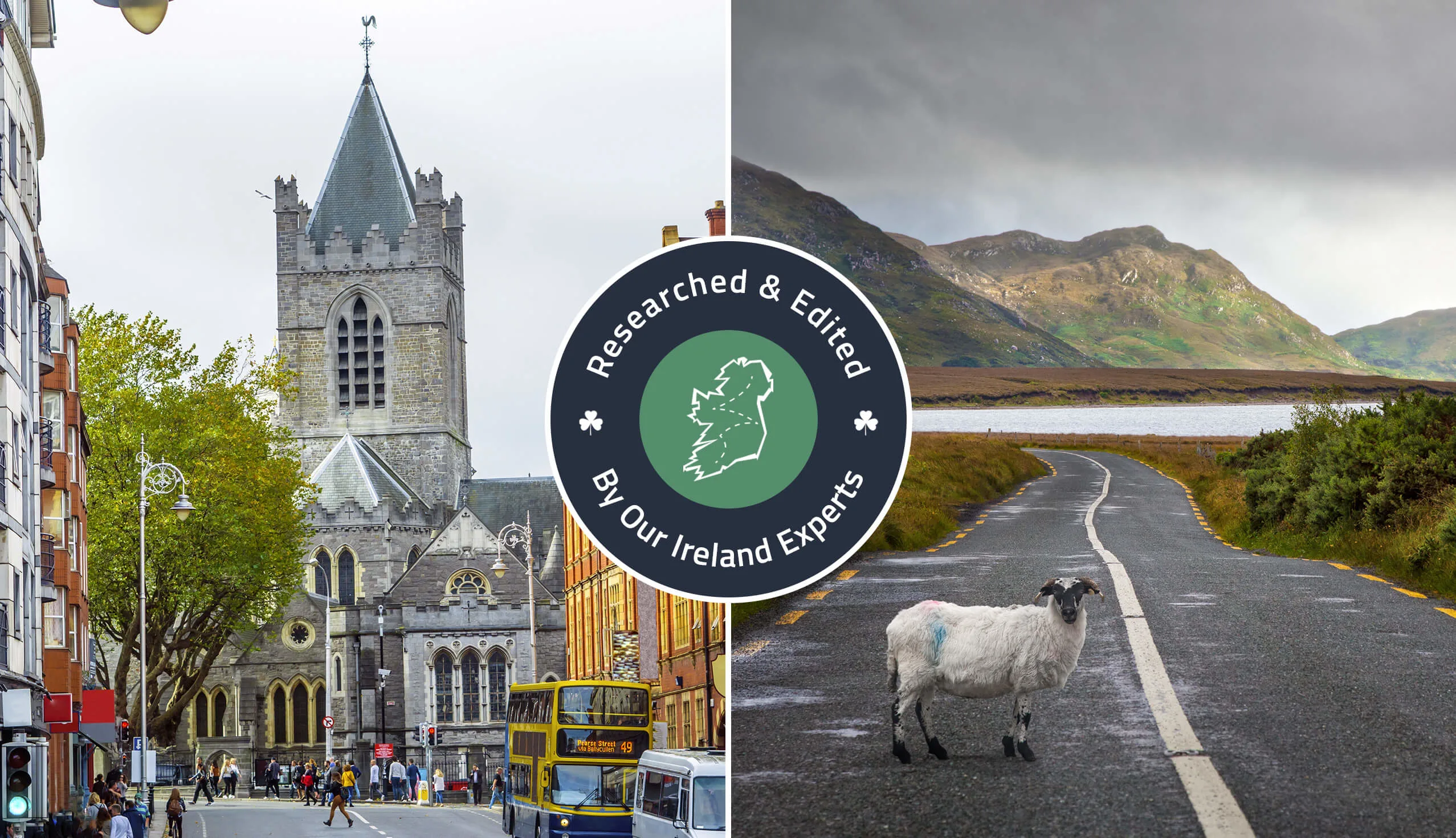Planning a 4-day Ireland itinerary can be a pain in the backside… So, we’ve done all of the hard work for you!
We’ve spent 25+ years travelling around Ireland and the itinerary below leans on that experience and the many mistakes we made along the way!
In a nutshell, this 4-day itinerary:
- Has been meticulously planned
- Has an hour-by-hour itinerary for each day to save you time/hassle
- Follows logical routes that take you to hidden gems, tourist favourites and great pubs and restaurants
Who this itinerary will suit
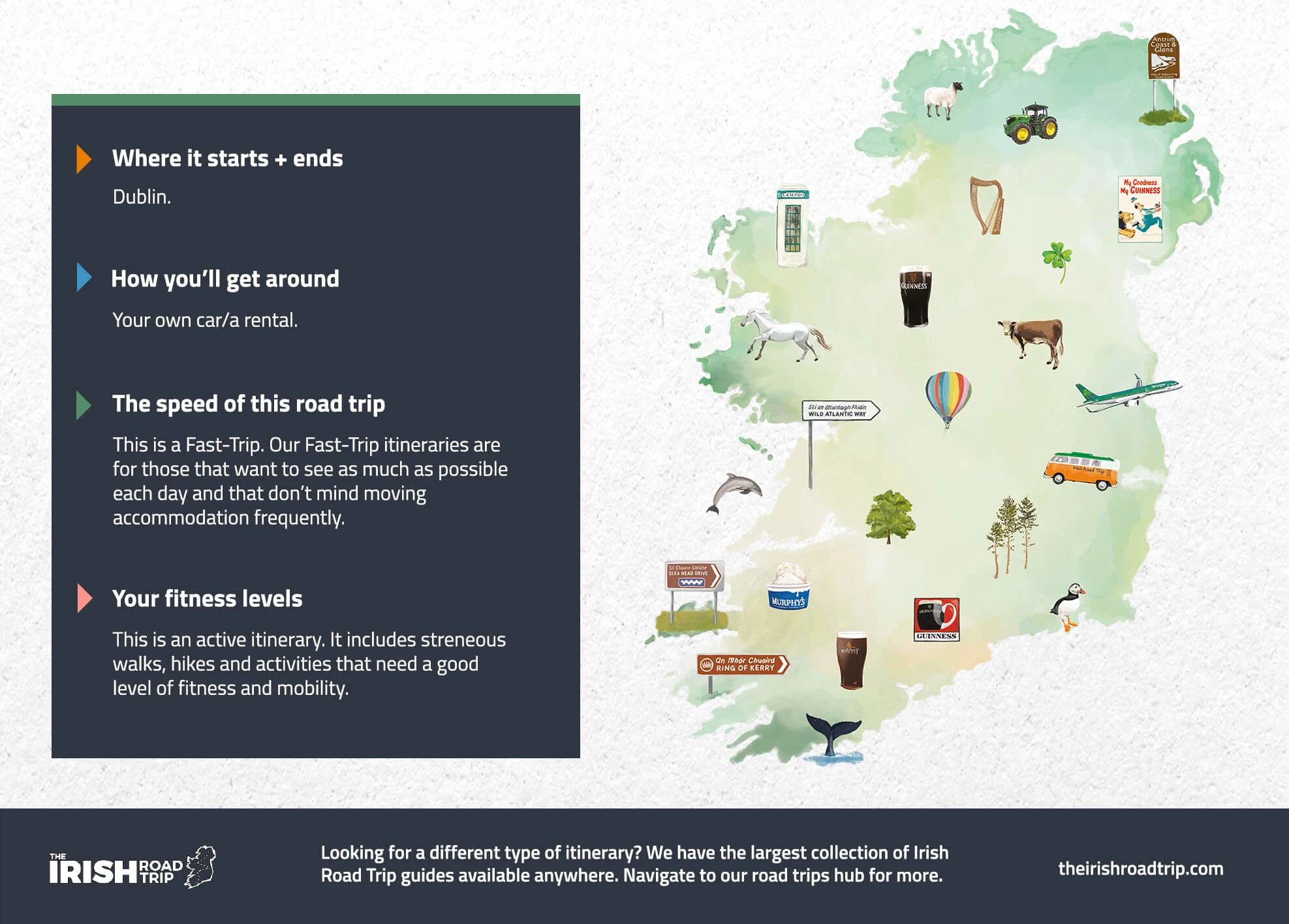
Now, before you scroll down, take 10 seconds to look at the graphic above – each of our road trip itineraries have been tailored to specific needs.
This road trip is specifically for those of you:
- Starting in/near Dublin
- Using your own car/a rental (if you’re renting a car, read this Irish car rental guide – it’ll save you time and hassle)
- Looking to explore at a fast pace
- With a good level of fitness (i.e. it includes long walks and hikes)
- Remember, we have hundreds of different itineraries here if this one doesn’t suit you
An overview of this 4-day Ireland itinerary

Click here for a high res map
The map above gives you a very high-level overview of where this route will take you.
It uses several bases (e.g. Dublin for 4 nights) and provides you with day-long road trips you can head off on, so you avoid having to change accommodation constantly.
Now, I’ll stop rambling on – here’s a day-by-day insight into each of the days below!
Day 1: Arrive in Dublin
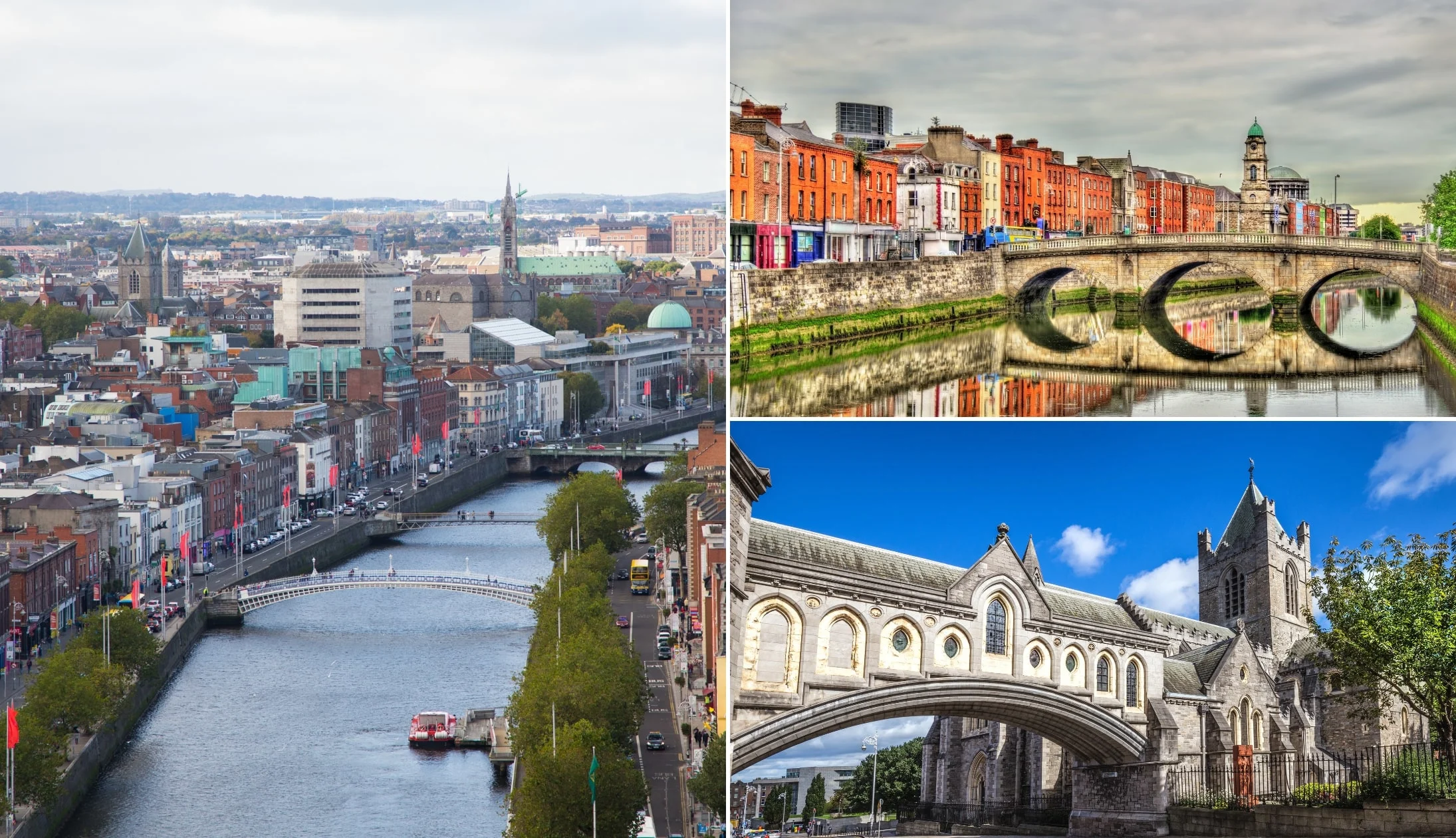
Photos via Shutterstock
Day 1 of this 4-day Ireland itinerary is going to be very dependent on the time that you arrive into Dublin. If you need to rent a car, I’d recommend collecting one at Dublin Airport. While you won’t need it for the first day in the city, it’ll save you from having to go and collect one at a later time.
For this itinerary, we’re going to make an assumption that you’ve landed in the morning and are ready to explore from mid-afternoon.
Recommended accommodation in Dublin
- Budget: Abigail’s Hostel (Temple Bar), Jacobs Inn (central hostel) and the Generator Hostel (short walk from the city)
- Mid-range: Dublin Skylon Hotel (just outside the city), Wren Urban Nest (Temple Bar) and the Harding Hotel (very central)
- Luxury: The Merrion (St. Stephen’s Green – very central) and The Westin (just off Grafton Street)
Getting around Dublin + money savers
- Time savers: If you want to avoid walking where possible, it’s worth getting a ticket for the Hop On Hop Off Bus around Dublin. It goes to or near all of the main sites on this itinerary plus plenty more.
- Money saver: If you’re visiting the ‘main’ Dublin attractions, the Dublin Pass can save you €€€ (here’s how)
Stop 1: Lunch
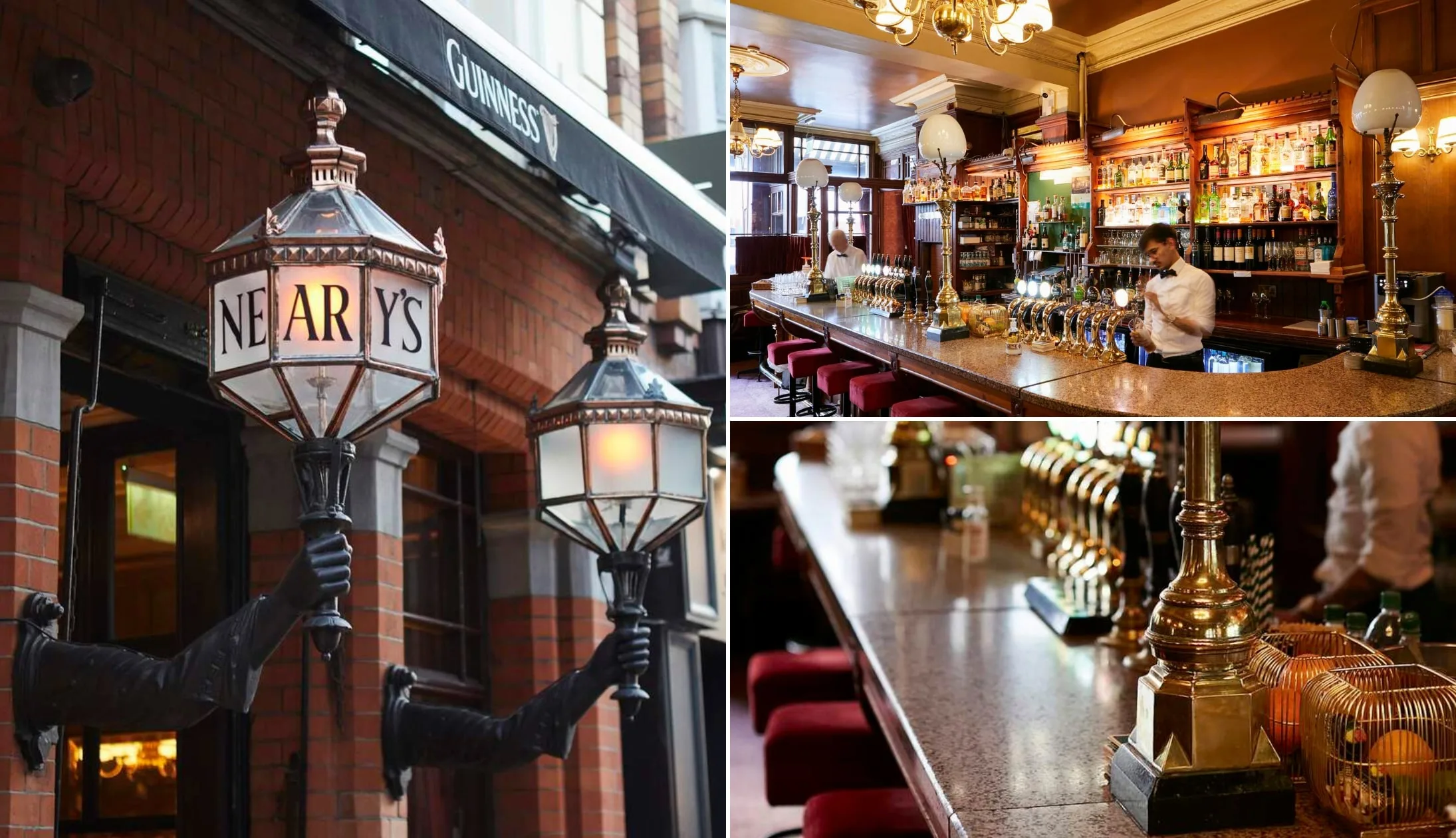
Photos © Tourism Ireland
There’s plenty of great restaurants in Dublin that serve up a delicious lunch, but if you fancy a tasty bite in a lovely old-world-style pub, Neary’s just off of Grafton Street is hard to bate!
They serve simple dishes (like soups and sandwiches) that are packed with flavour and great value for money. Alternatively, Sprout and Co. on Dawson St. is also a great choice.
They have a range of hearty salad bowls, with good options for vegetarians and vegans.
Stop 2: Trinity College
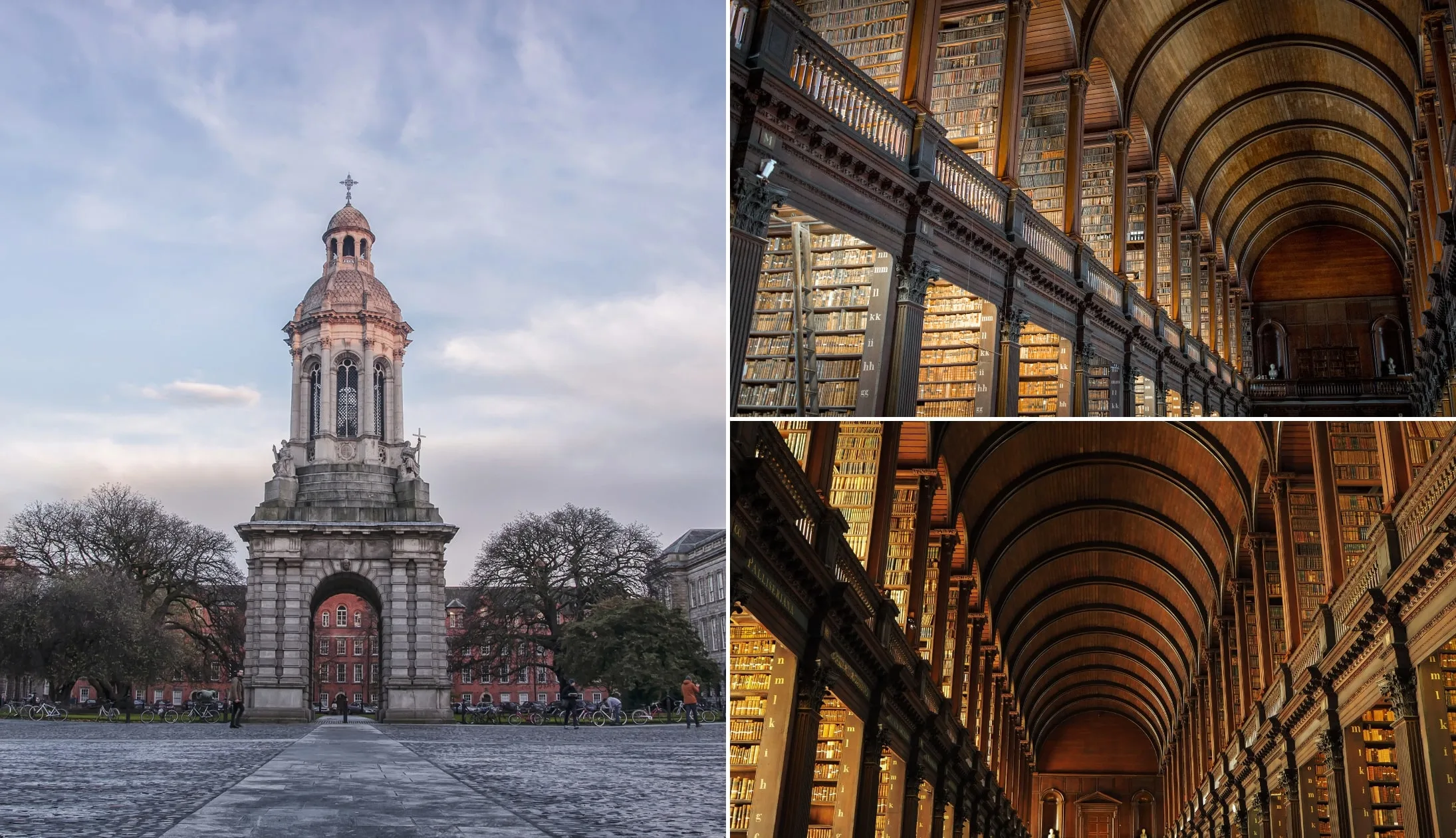
Photos via Shutterstock
Now you’re all fuelled up, it’s time to head to Trinity College to see the Book of Kells, arguably the most famous cultural attraction in Dublin.
If you can, we highly recommend pre-booking your tickets online, as the queues can get really long (bordering on ridiculous!). This fast-track ticket allows you to dodge the queue and gets you into Dublin Castle, too!
Spend around one hour seeing the Book of Kells, walking around the exhibit, and taking in the beauty of the Old Library. After that, give yourself another 20 minutes or so to walk around the university campus.
Stop 3: The Ha’penny Bridge (via Temple Bar)
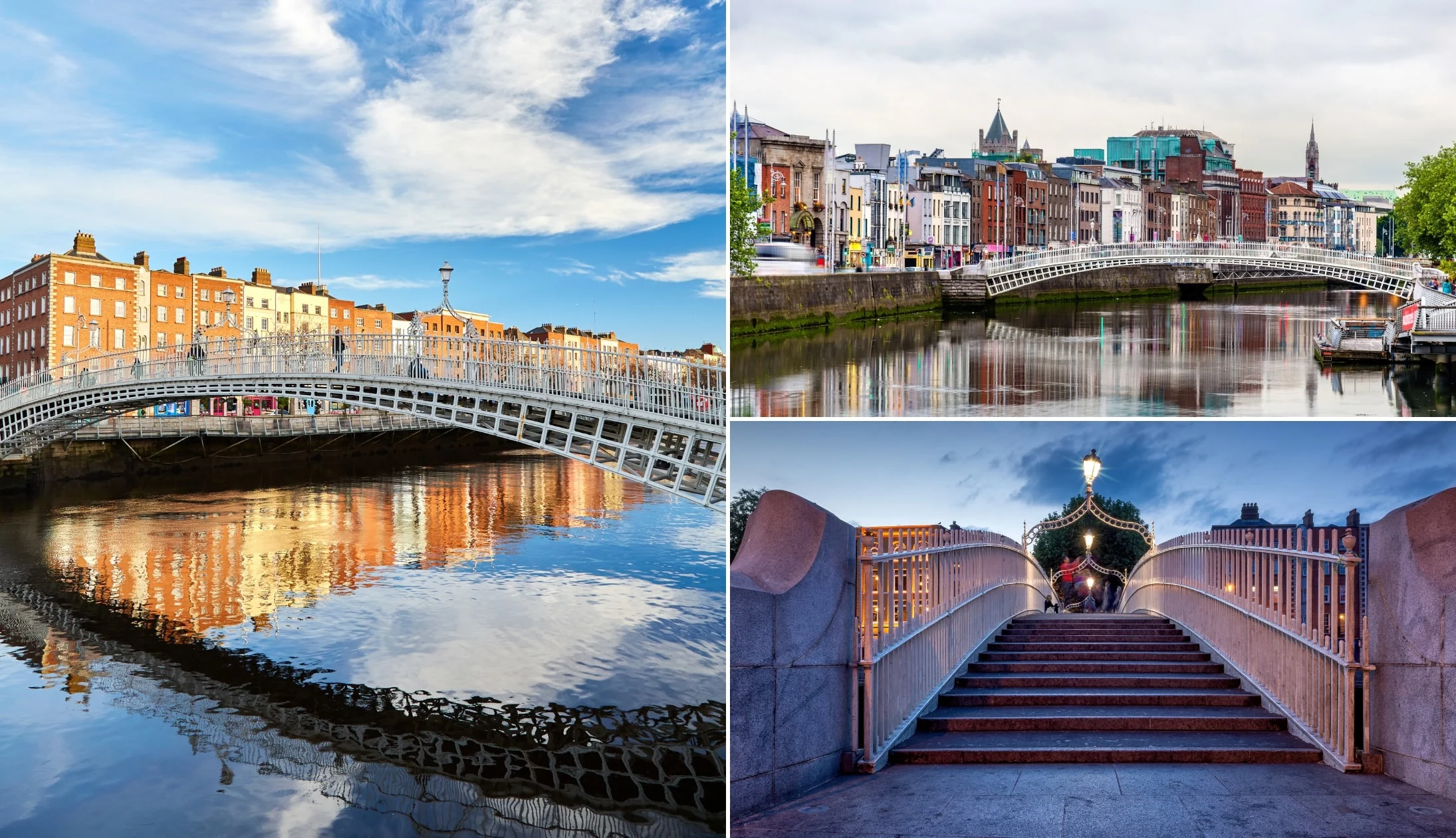
Photos via Shutterstock
The Ha’penny Bridge (officially named the Liffey Bridge) dates back to 1816 and was the first pedestrian bridge over the River Liffey!
It’s a seven-minute walk from the Trinity Gates, but feel free to take your time as you make your way through the lively streets of Temple Bar.
Now, Temple Bar can be a bit of a tourist trap. If you fancy a pint, here are several pubs in Temple Bar worth trying (the Palace is our go-to).
If you feel like an afternoon coffee, there are some great cafes in the Temple Bar area or on the other side of the river. Joe’s Coffee and Vice Coffee are two of our favourites across the water.
They’re both just a short stroll from the north side of the Ha’penny Bridge.
Stop 4: Dublin Castle
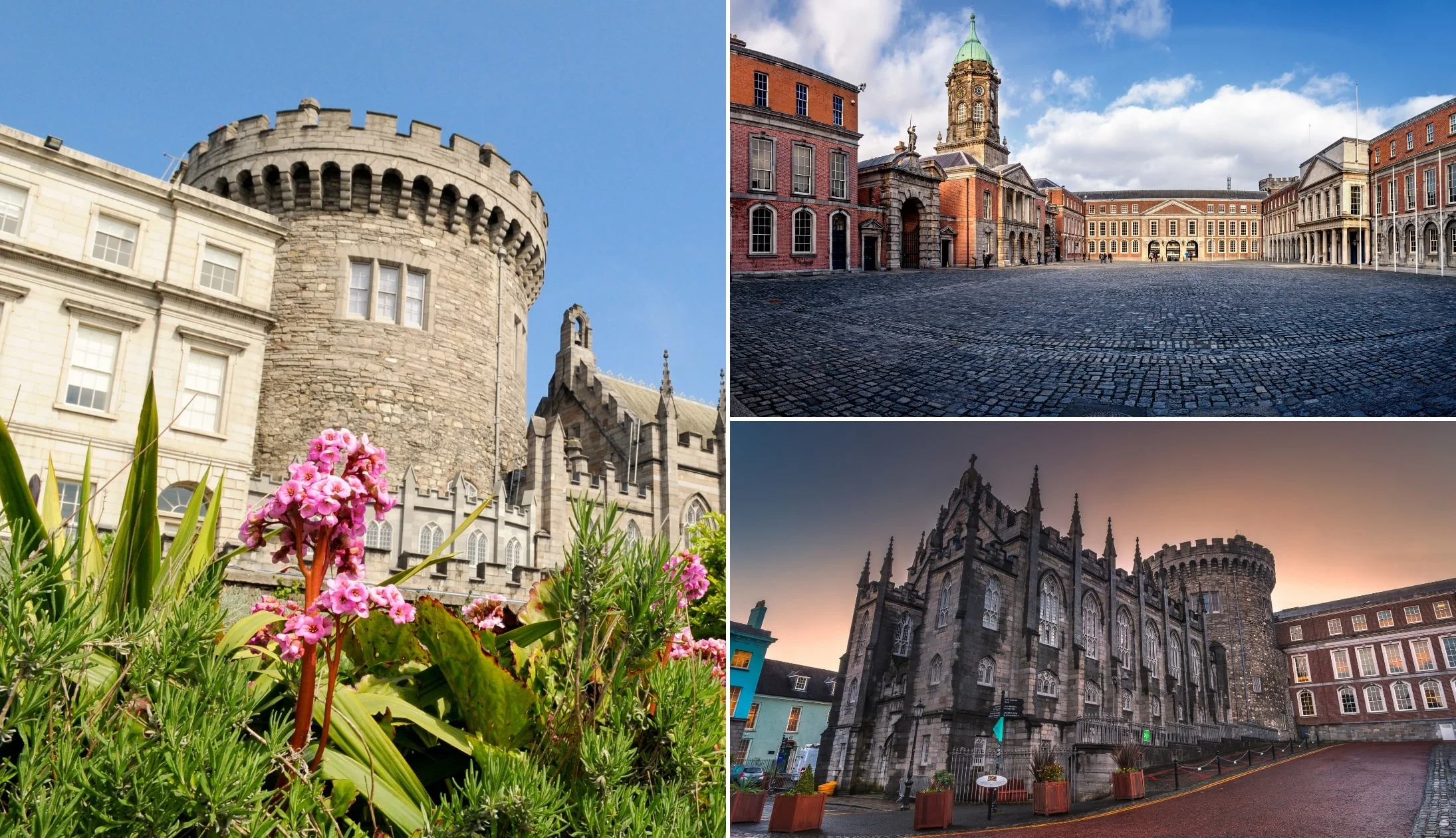
Photos via Shutterstock
Next on the itinerary is Dublin Castle. Nestled in the city centre, the castle dates back to the 13th century and was the seat of the English for over 700 years.
Today, it’s an important government complex and the site of Presidential Inaugurations and key State events. The castle is around 10 minutes from the Ha’penny Bridge on foot.
There’s no admission fee to explore the grounds, but if you want to have a look inside you’ll need to purchase tickets for either a self-guided tour or a guided tour.
Guided tours include access to the State Apartments, Exhibitions, Chapel Royal, and the Mediaeval Undercroft. Self-guided tours include access to the State Apartments and Exhibitions only.
Tickets for guided tours can be purchased on the day of your visit at the ticket booth.
Stop 5: Christ Church Cathedral
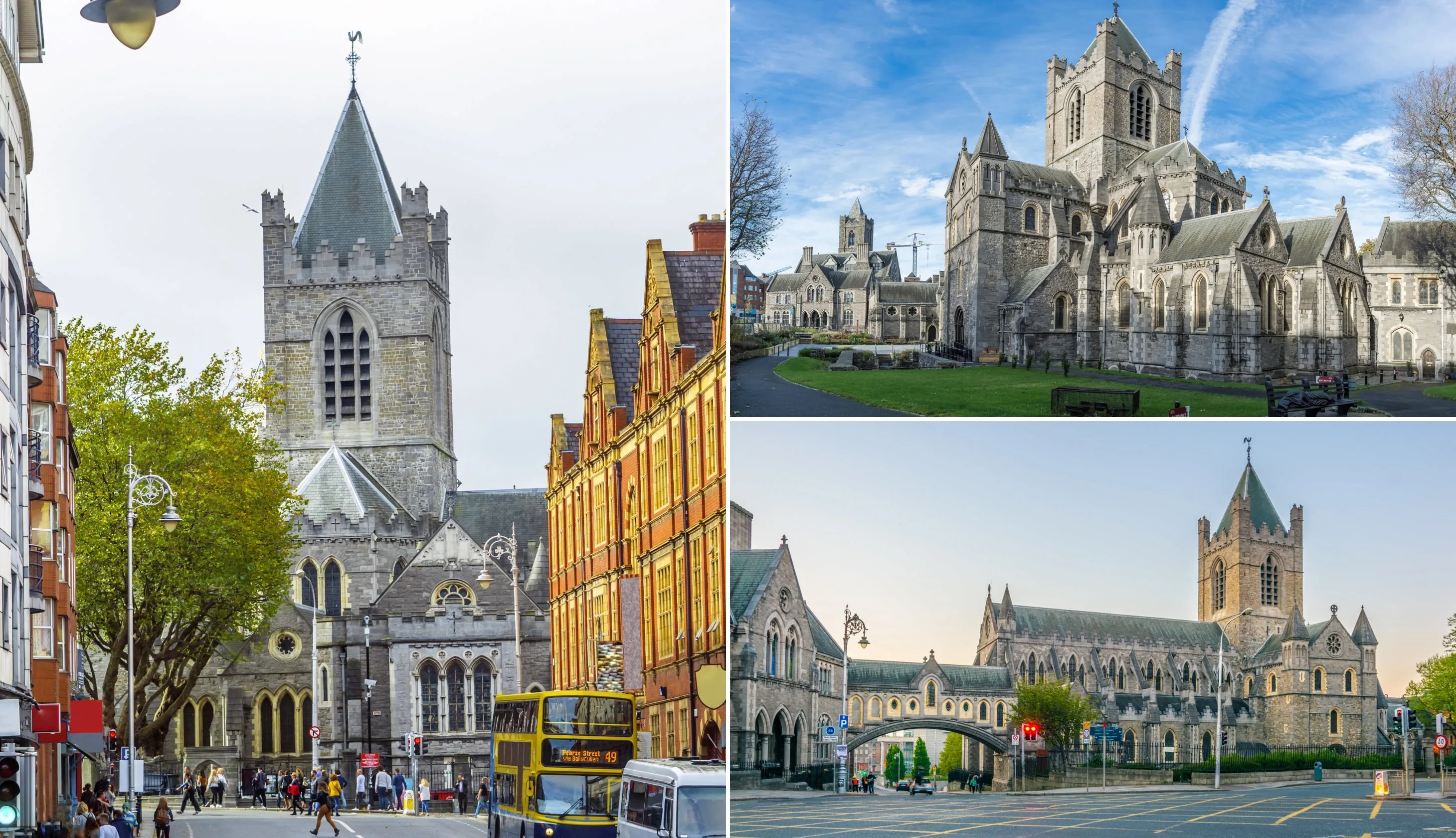
Photos via Shutterstock
Christ Church Cathedral dates back to the early 11th century when it was founded under Sigtrygg Silkbeard, a Norse King of Dublin. It was rebuilt later in stone, largely thanks to the first Anglo-Norman archbishop, John Cumin, in the late 12th century.
The cathedral is only a 4-minute walk from Dublin Castle and a really interesting place to visit. Some highlights are the restored crypt houses, Strongbow’s tomb, and the Treasures of Christ Church exhibition.
You can grab a ticket online here – these include an audio guide that comes in several languages, with three themes to choose from – ‘Power and Politics’, ‘Music and Spirituality’, and ‘Christ Church and the City’.
Self-guided tours with an audio guide usually last around one hour.
Stop 6: St. Patrick’s Cathedral
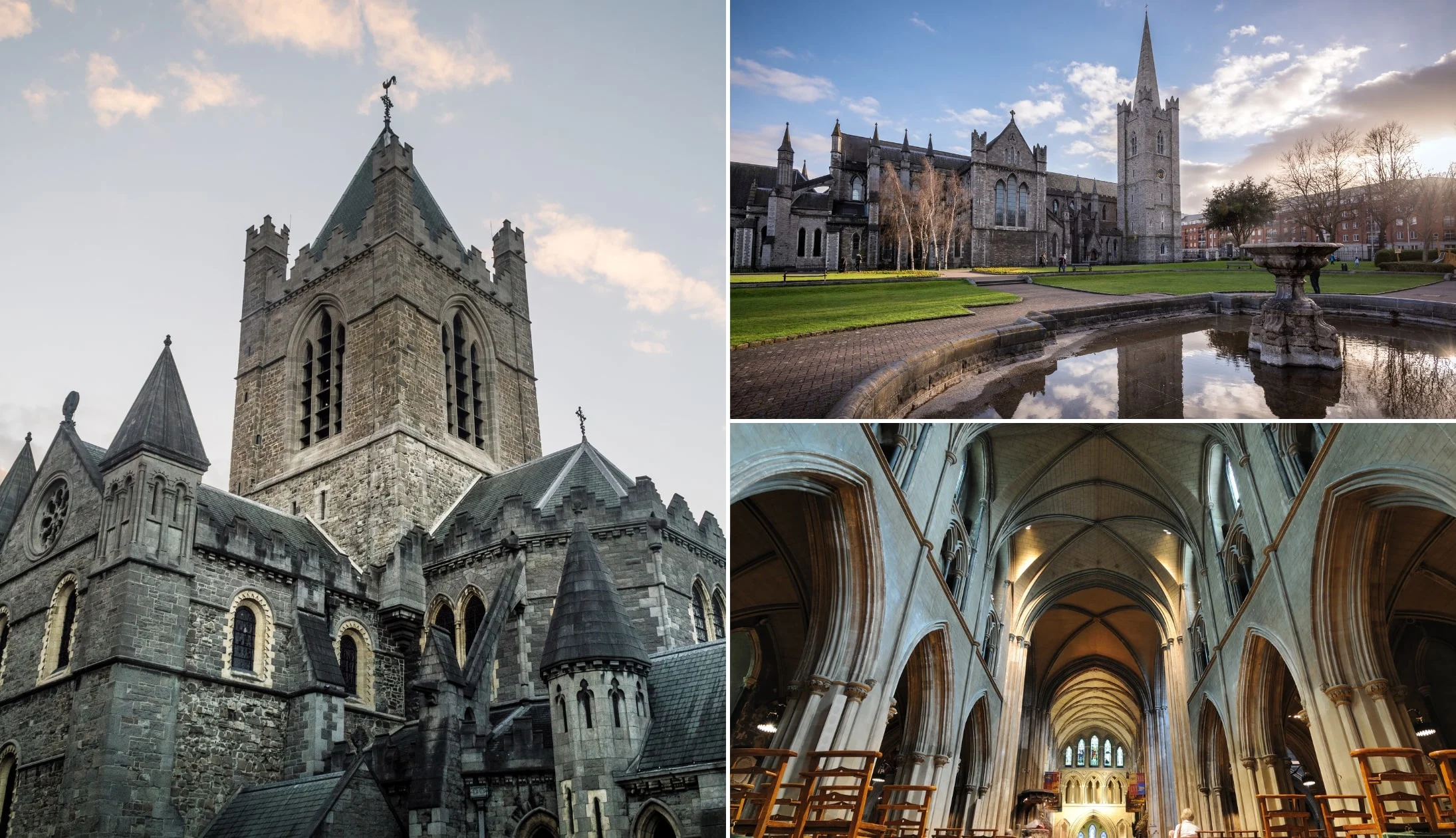
Photos via Shutterstock
St. Patrick’s Cathedral is just a short 7-minute walk from Christ Church Cathedral. The magnificent cathedral is one of the city’s top attractions as well as one of the few remnants of Medieval Dublin!
It dates back to the 12th century and is Ireland’s largest cathedral. As you may expect, St. Patrick’s Cathedral has a long and rich history. The cathedral has fallen into disrepair and has been damaged several times, most notably in the early 19th century.
During this period, it was restored by none other than Benjamin Lee Guinness (the first Lord Mayor of Dublin and owner of Guinness).
Stop 7: Teeling’s Distillery
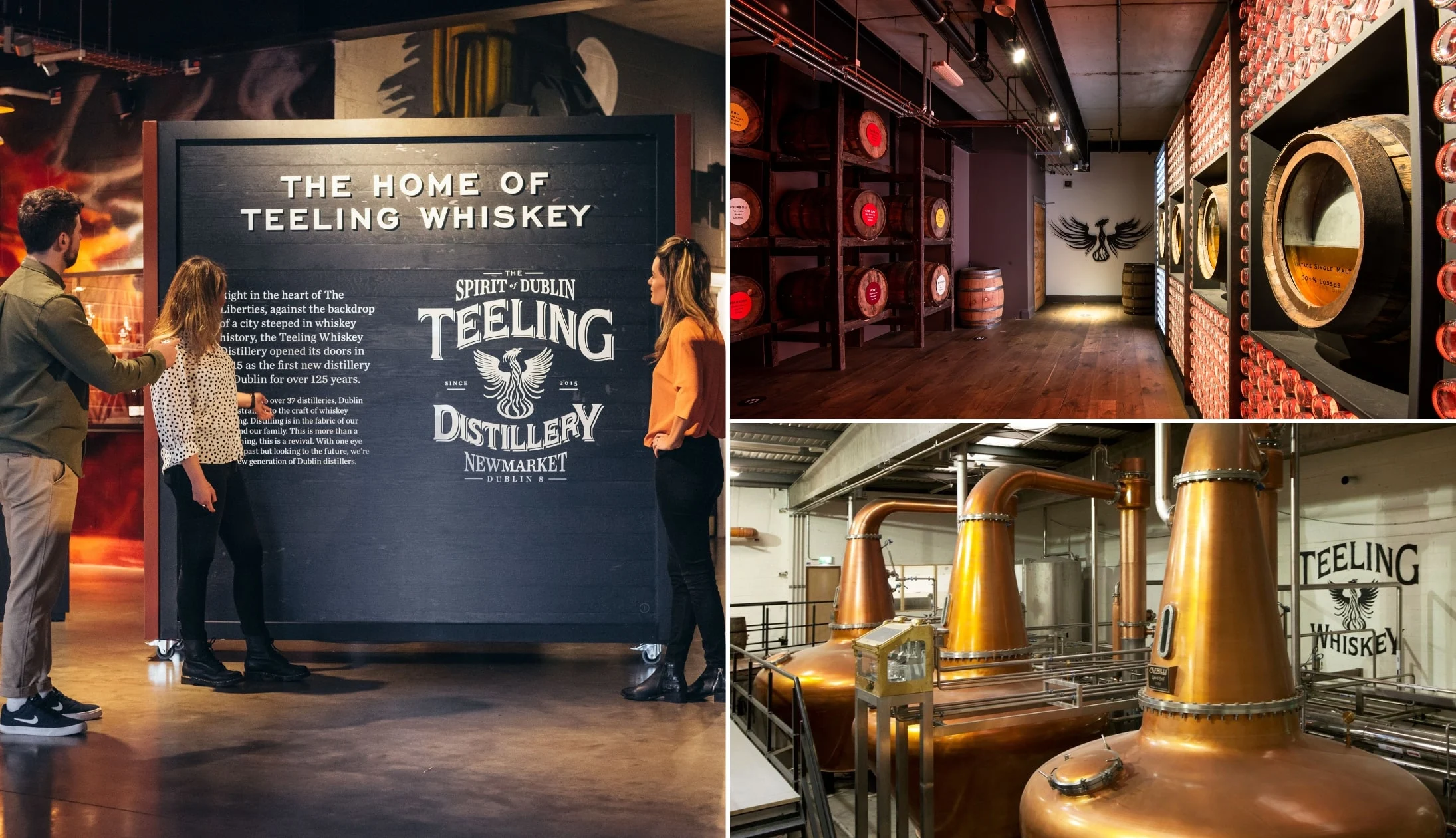
Photos courtesy Teeling Whiskey Distillery via Failte Ireland
Once you’ve had your fill of St. Patrick’s, head on over to the Teeling Distillery, an 8-minute walk away. Founded by the Teeling family in 2015, the Teeling’s Distillery was the first new distillery to open in Dublin in over 125 years!
However, the family’s expertise span back generations, as they established a small craft distillery on Marrowbone Lane in 1782. Today, the new distillery stands just a few streets away from the family’s ancestral distillery.
They have several tours available, each of which has great reviews online. You can grab a ticket online before you go that includes a fully-guided tour of the distillery, followed by a tasting.
Stop 8: Dinner, drinks and live music
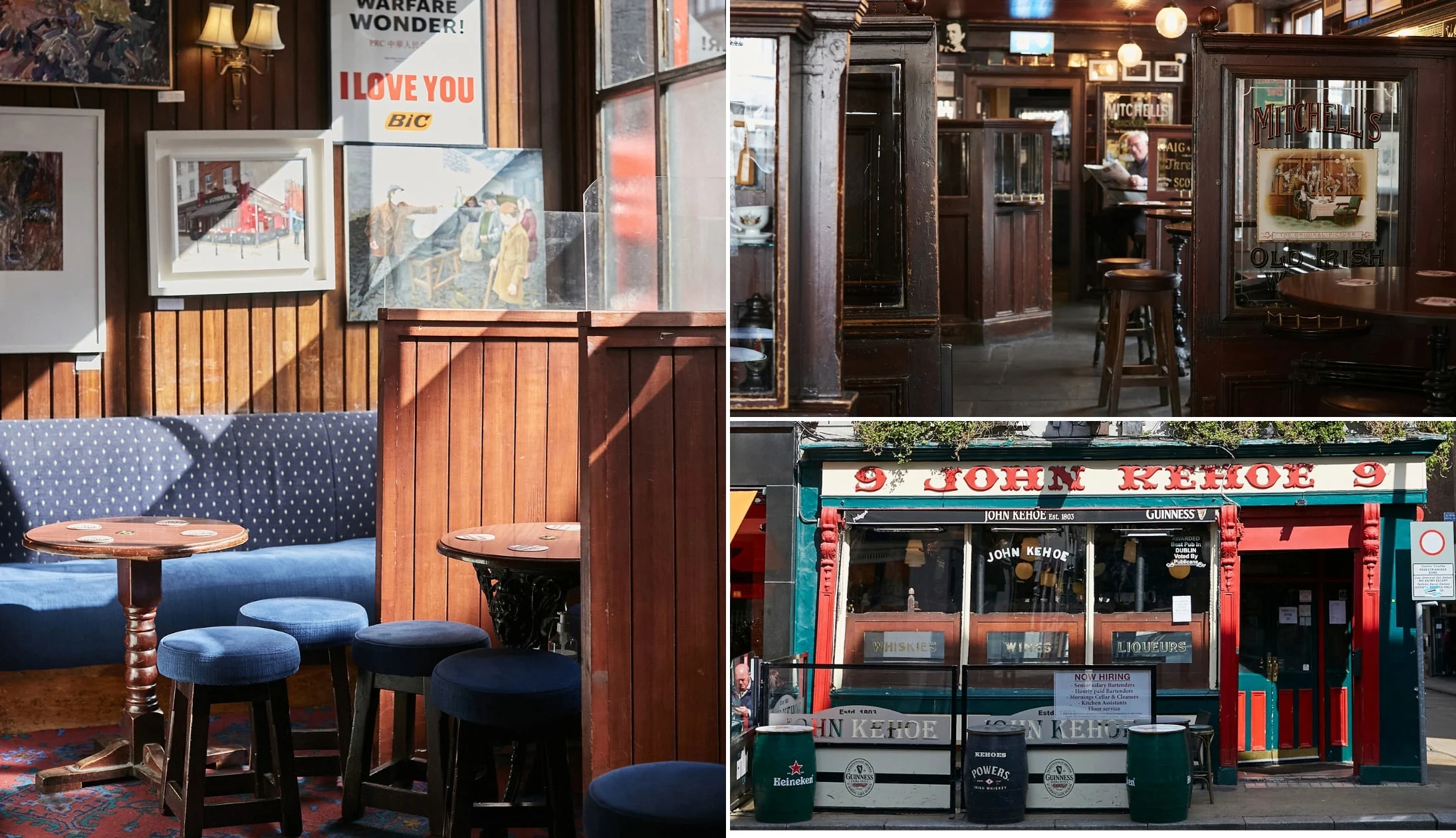
Different trad bars in Dublin. © Tourism Ireland
By now you must be getting hungry. Dublin has heaps of options for dinner, but we’ve got a couple of suggestions for you!
Our dinner recommendations
If you’re looking for something close by, Spitalfields is a stone’s throw from the Teeling’s Distillery. It’s a little bit pricey, but the atmosphere is great and the food is top-notch!
However, Spitalfields is 16+ only, so it’s not suitable for young families. Otherwise, check out The Bull and Castle across the street from Christ Church Cathedral.
Their menu has F.X. Buckley Steaks (renowned in Dublin), plus a great selection of local craft beers. The restaurant can get booked out pretty quickly, but you can always eat in the bar upstairs, which also has steak on the menu.
Live music and trad bars
If you want a taste of what Dublin’s best pubs are, see our detailed Dublin pubs guide. If you’re solely looking for places that do exceptional Guinness, see our guide to Dublin’s best pints.
If you fancy a bit of live music, there’s plenty on offer. Pipers Corner on Marlborough St. has some great tunes, with live music from 9pm every Tuesday to Saturday, and from 8pm on Sunday.
The inside has more of a modern feel, but you’ll be guaranteed authentic Irish music.
For the full experience, O’Donoghues Bar on Merrion Row has live music every night of the week. It’s about as traditional as Irish pubs get, with a brilliant atmosphere.
The Celt is another fantastic pub with live music every night from 9pm, although it’s not always traditional.
Day 2: Wicklow’s Wonders
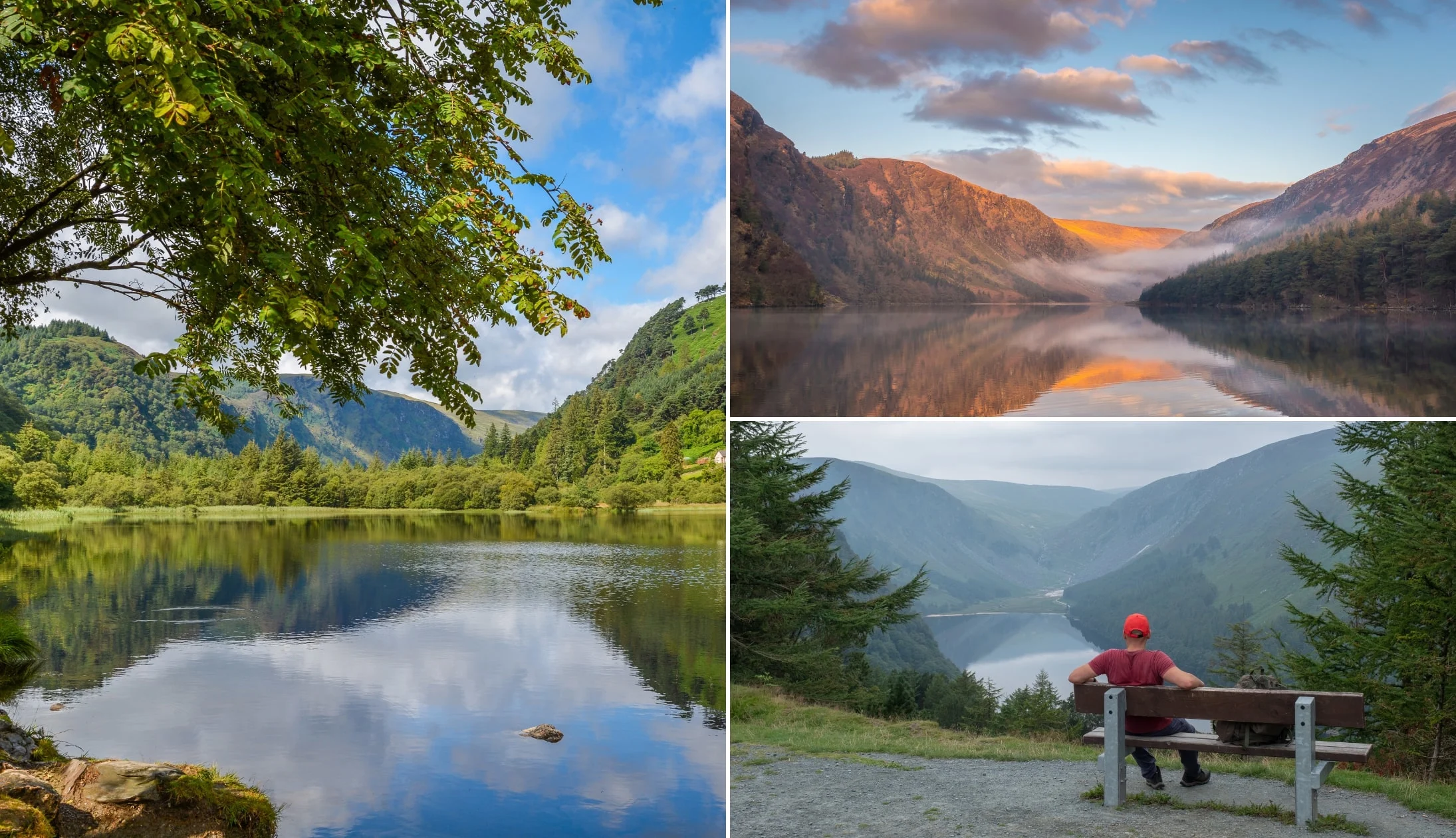
Photos via Shutterstock
On day 2 of your 4 days in Ireland itinerary, it’s time to put that rental car to use and head out of Dublin.
Today, you’ll be exploring Wicklow, also known as the Garden of Ireland.
Get yourself some breakfast either where you’re staying or at a cafe nearby. Then, double-check there’s a good amount of fuel in the car before heading to beautiful Wicklow via Sally Gap.
Stop 1: The Sally Gap Drive (multiple stops)
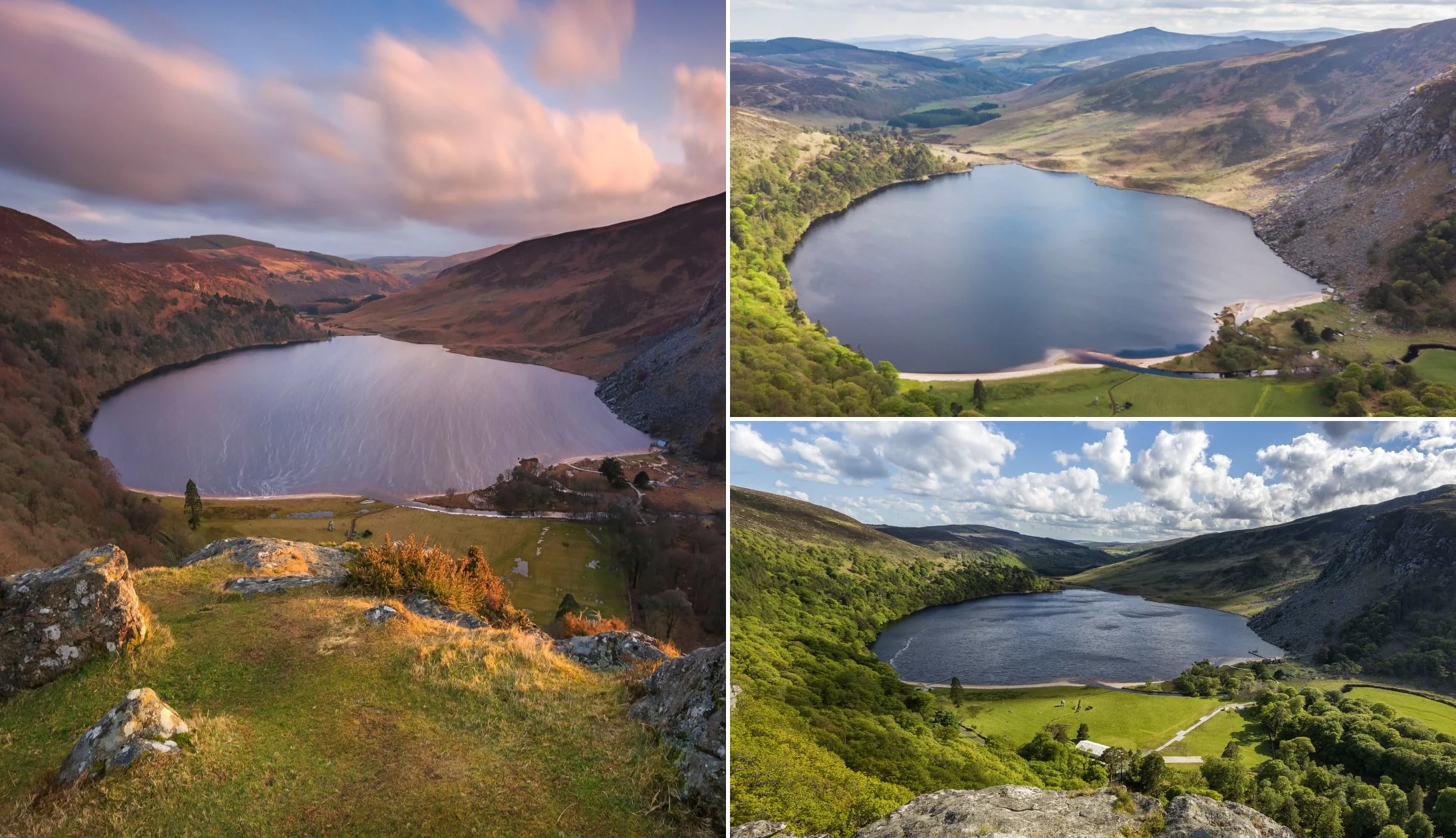
Photos via Shutterstock
The glorious Sally Gap Drive can’t be missed and you’re best off doing it either before you head to Glendalough, if you’re up early, or after, on your way home.
The reason for this is that you’re best off getting to Glendalough as early as you can, as it tends to get very busy at times.
When you do get to do the drive, aim for Lough Tay, first. Also known as Guinness Lake, Lough Tay is the jewel in Sally Gap’s crown!
From here, follow the winding road down, over the PS I Love You bridge and around until you reach a car park (on your right).
From here, very carefully walk around and get an eyeful of Glenmacnass Waterfall before heading on to Glendalough.
If you’re feeling up for a walk, we’ve got two for you to choose from. There’s the Djouce Mountain Walk and the Ballinastoe Woods Walk, both of which range from 2 to 2.5 hours in length.
Stop 2: Glendalough Visitor Centre and Monastic City
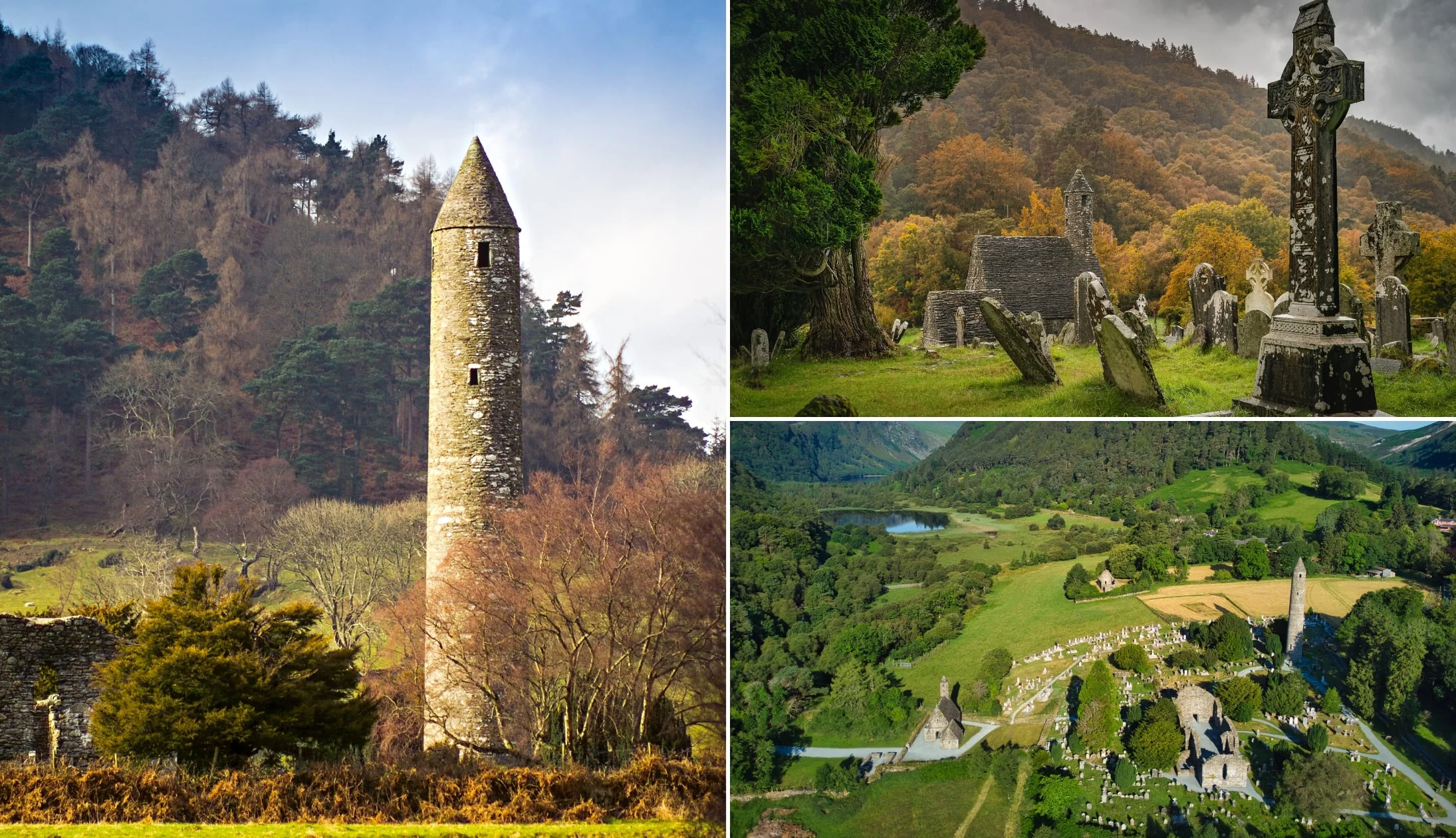
Photos via Shutterstock
Park up at the Glendalough Visitor Centre (the Lower Car Park – €4) and plan to spend between one and 30 – 45 minutes exploring the centre and the ‘Monastic City’ (your next stop).
The visitor centre is right next to the Monastic City, one of the most important monastic sites in the country. The city was founded by St. Kevin in the 6th century and went on to become one of Europe’s most famous religious sites!
At the centre, there’s a wonderful exhibition on the history of Glendalough and St. Kevin. There’s also an interesting 15-minute long audio and visual presentation about early Irish Saints and monasteries.
Now you’ve learned about the site, it’s time to take a 2-minute stroll to the Monastic City next door. Whilst the remains of the city are scattered all across the glen, many of the main ruins and features are within walking distance of the visitor centre.
These include the Glendalough Round Tower, one of the city’s most well-known landmarks. It stands 33 metres high and dates back almost 1000 years! Other attractions nearby include St. Kevin’s Church and the Glendalough Cathedral ruins.
Stop 3: The Spinc Walk
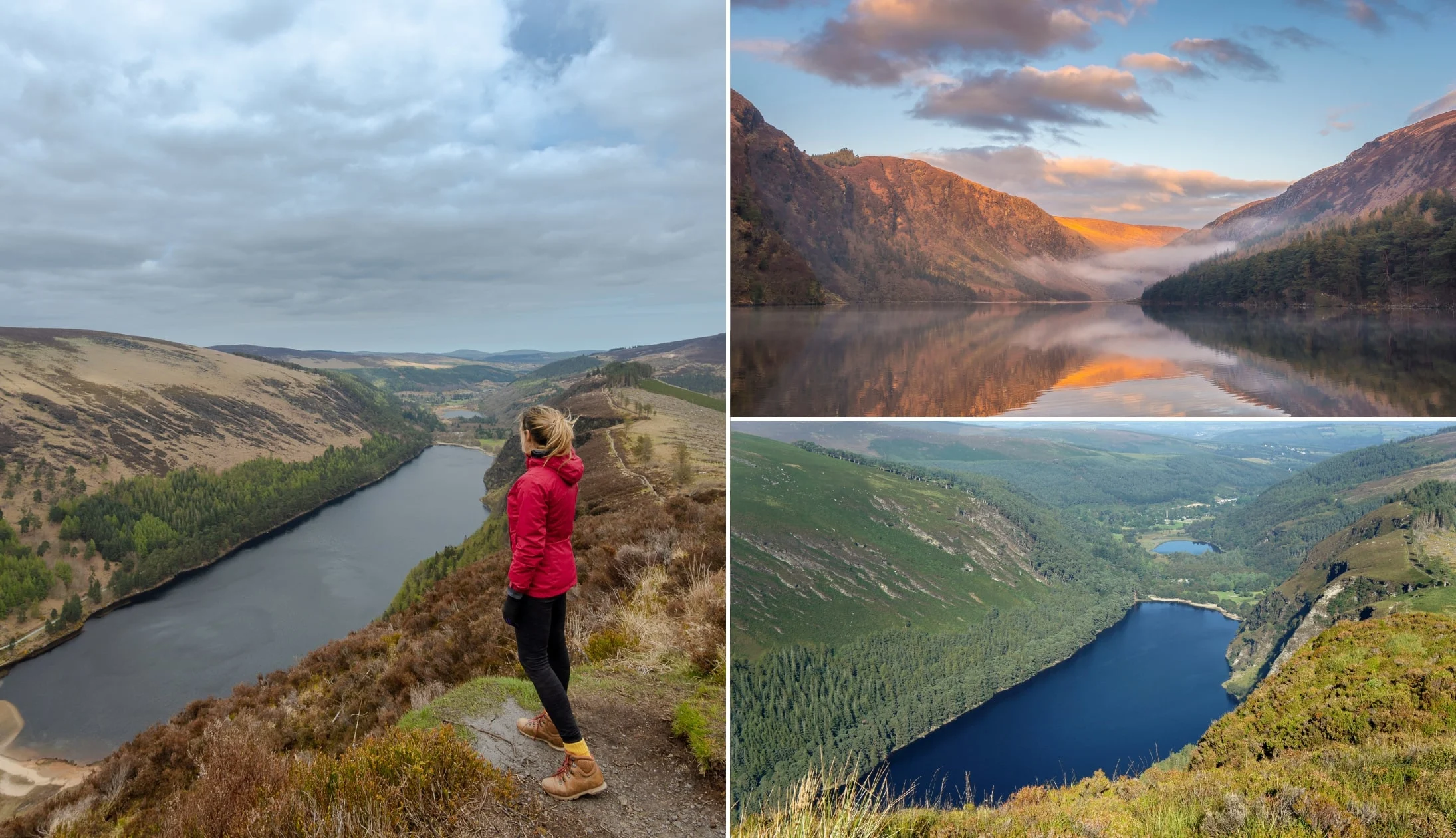
Photos via Shutterstock
The Spinc Walk is one of the finest trails in Glendalough. The Spinc Loop takes you on a 9.5 km ramble with some steep inclines and tricky paths.
There’s some steep climbing and over 600 steps near the start, but after that, it’s a little more relaxed, though there are some tricky downhill sections later.
It’s a moderate to strenuous walk, with a total ascent of 380 metres. Having said that, if you’re in reasonable shape, you should be okay and most people complete the walk in just over 3 hours.
Stop 4: Lunch at the Wicklow Heather

Photo left: The Irish Road Trip. Others: Via Wicklow Heather
We absolutely love stopping by the Wicklow Heather for lunch whenever we’re in Glendalough. The restaurant is in the heart of idyllic Laragh, with a historical interior and some lovely outdoor seating areas.
It’s only a 6-minute drive from the Upper Lake Car Park.
The menu has traditional Irish dishes, like comforting seafood chowder or hearty cottage pies, with an option for vegetarians and vegans.
Stop 5: Powerscourt Waterfall
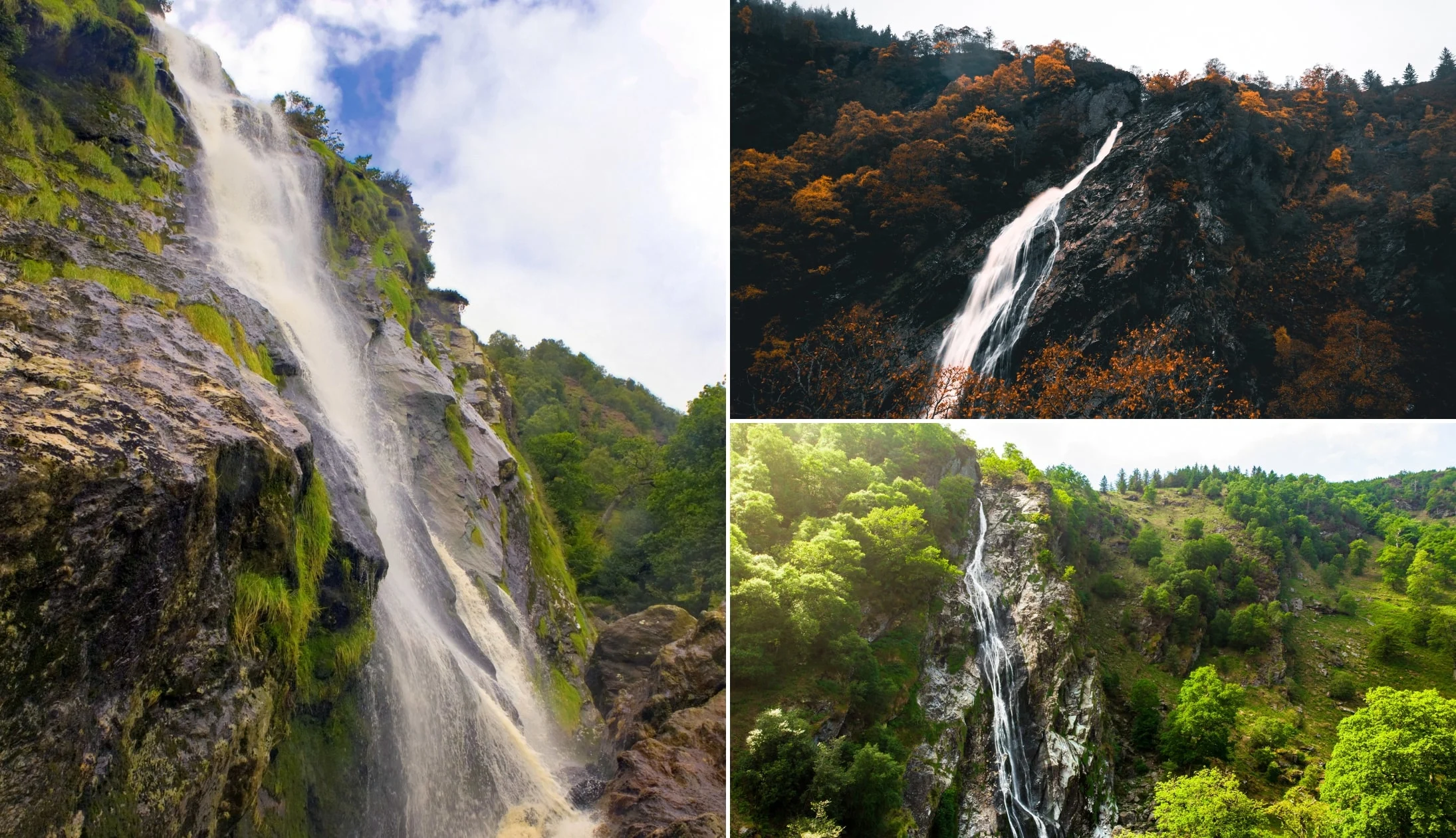
Photos via Shutterstock
From the Wicklow Heather, Powerscourt Waterfall is around a 30-minute drive away. The waterfall stands 121 metres high, making it the tallest waterfall in Ireland! It’s a beautiful spot, with the water cascading down the rock face, surrounded by trees.
At the waterfall, you’ll find a dedicated car park, toilets, and in the summer, a refreshment kiosk selling drinks and snacks.
There’s a lovely walking route that takes around 30 minutes to complete, giving walkers nice views of the falls and surrounding parkland.
There are some small inclines, so make sure to put on some appropriate footwear.
Stop 6: Bray Seaside Stroll
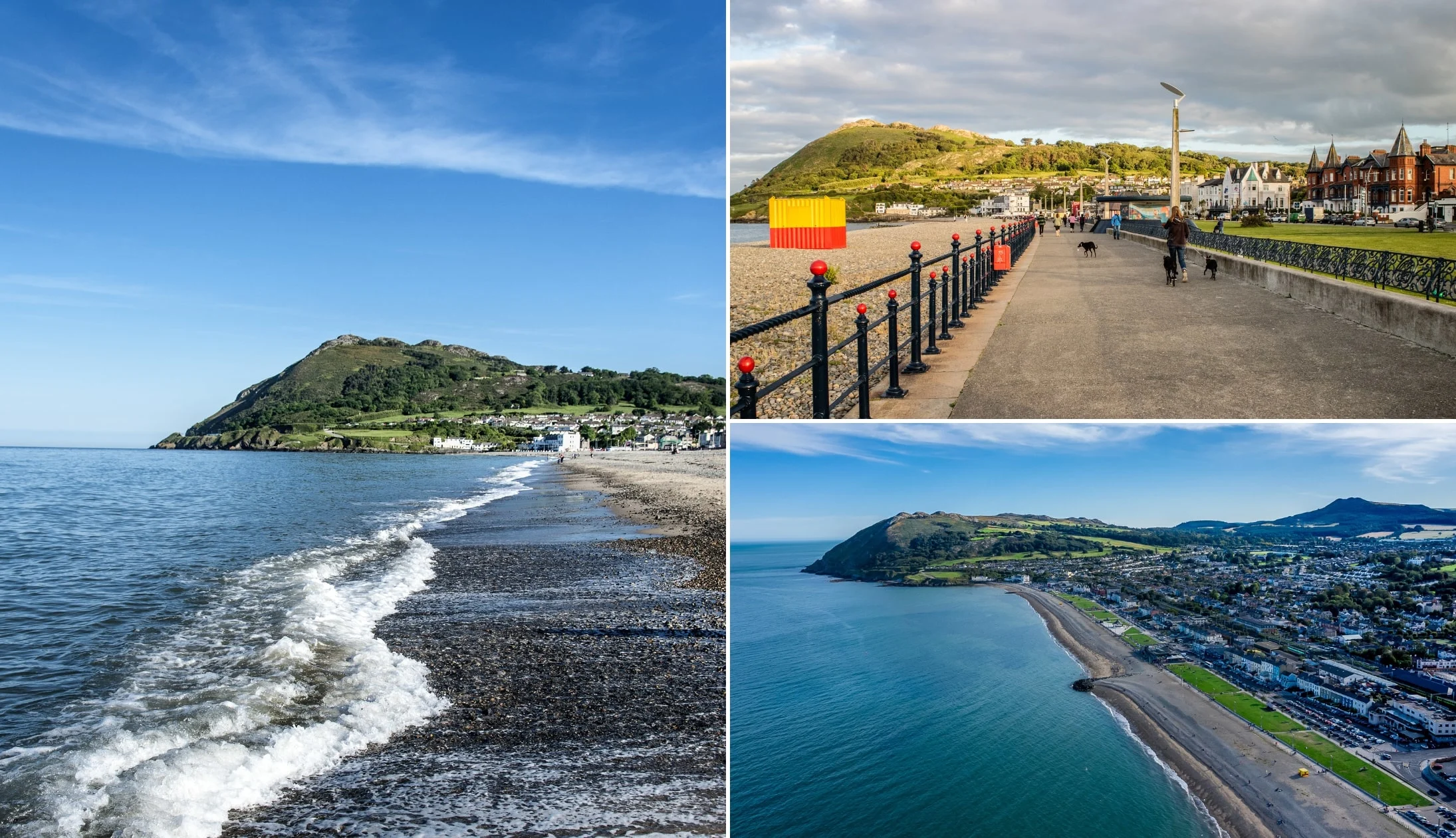
Photos via Shutterstock
Hop in the car and drive 17 minutes towards Bray. The best place to park is at the Bray Council Car Park here. It’s right above the beach, so it’s just a short stroll to the sand.
Bray Beach is a sandy and shingle beach over 1.6km long. You can walk along the sand or along the promenade towards Bray Head and back.
Stop 7: Back to Dublin for the night

Different trad bars in Dublin. © Tourism Ireland
After a long (and hopefully enjoyable!) day of exploring, it’s time to say goodbye to Wicklow and head back to Dublin.
If you’re already feeling a little hungry, break up the journey by stopping at Johnnie Foxes for dinner. It’s a lively traditional pub serving up hearty Irish food and great pints.
They run a daily ‘Hooley Show’ with Irish dancing and music. You can buy tickets (which include a four-course dinner) on their website.
Johnnie Foxes is 15 minutes from Powerscourt House and another 40 minutes to Dublin, depending on traffic.
Or, if you head straight back to Dublin, here are some food and pub recommendations for you.
Our dinner recommendations
If you’re looking for something close by, Spitalfields is a short walk from the cathedral. It’s a little bit pricey, but the atmosphere is great and the food is top-notch!
However, Spitalfields is 16+ only, so it’s not suitable for young families. Otherwise, check out The Bull and Castle across the street from Christ Church Cathedral.
Their menu has F.X. Buckley Steaks (renowned in Dublin), plus a great selection of local craft beers. The restaurant can get booked out pretty quickly, but you can always eat in the bar upstairs, which also has steak on the menu.
Live music and trad bars
If you want a taste of what Dublin’s best pubs are, see our detailed Dublin pubs guide. If you’re solely looking for places that do exceptional Guinness, see our guide to Dublin’s best pints.
If you fancy a bit of live music, there’s plenty on offer. Pipers Corner on Marlborough St. has some great tunes, with live music from 9pm every Tuesday to Saturday, and from 8pm on Sunday.
The inside has more of a modern feel, but you’ll be guaranteed authentic Irish music.
For the full experience, O’Donoghues Bar on Merrion Row has live music every night of the week. It’s about as traditional as Irish pubs get, with a brilliant atmosphere.
The Celt is another fantastic pub with live music every night from 9pm, although it’s not always traditional.
Day 3: Mighty Meath and Louth
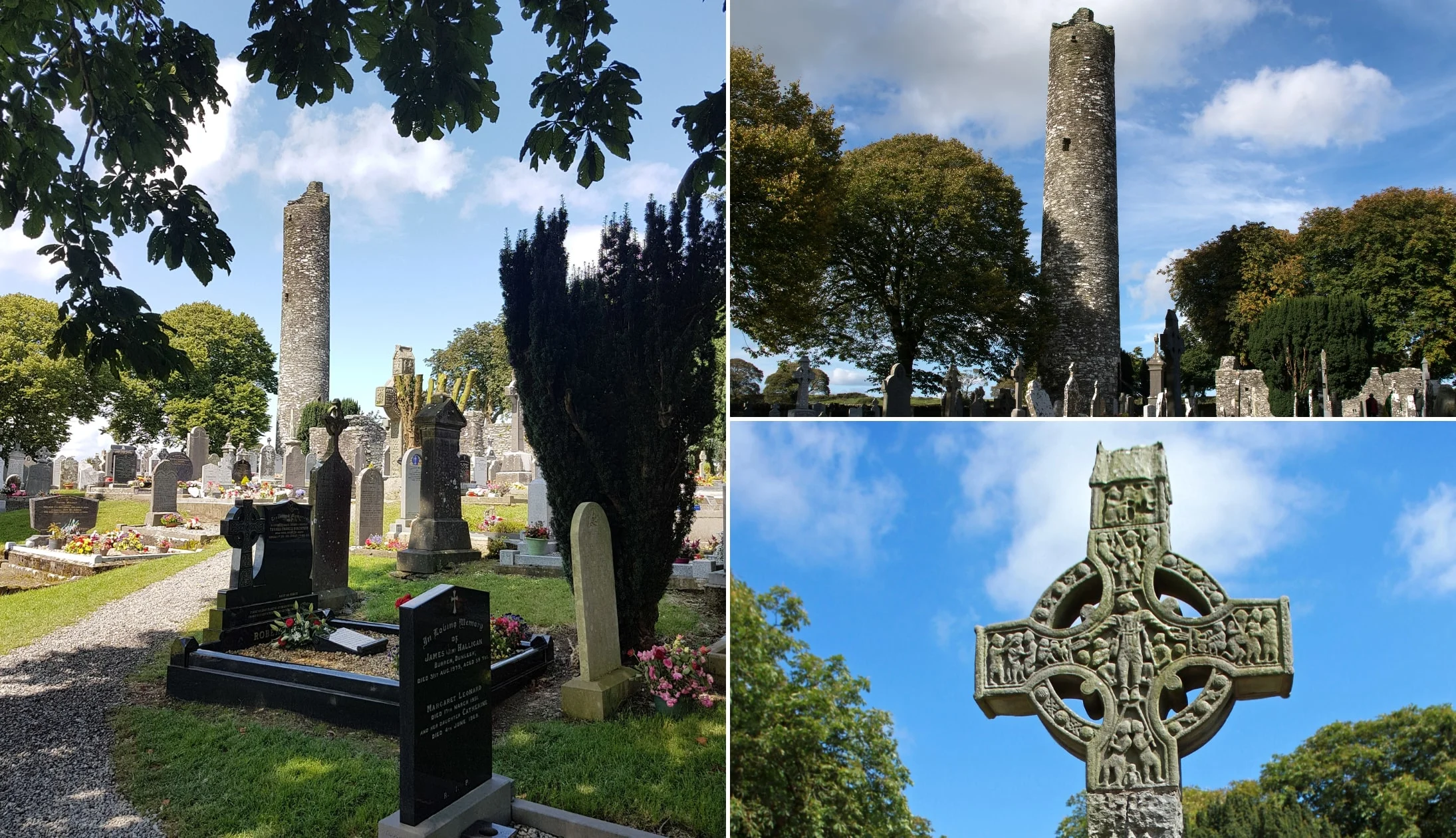
Photos via Shutterstock
On day 3 of the 4 days in Ireland itinerary, you’ll be heading out to County Meath, known for its archaeological sites.
Today, we recommend getting breakfast either at your accommodation or a nearby cafe. There won’t be places to grab a bite near your first stop, so it’s best to eat before you leave Dublin.
Stop 1: Newgrange
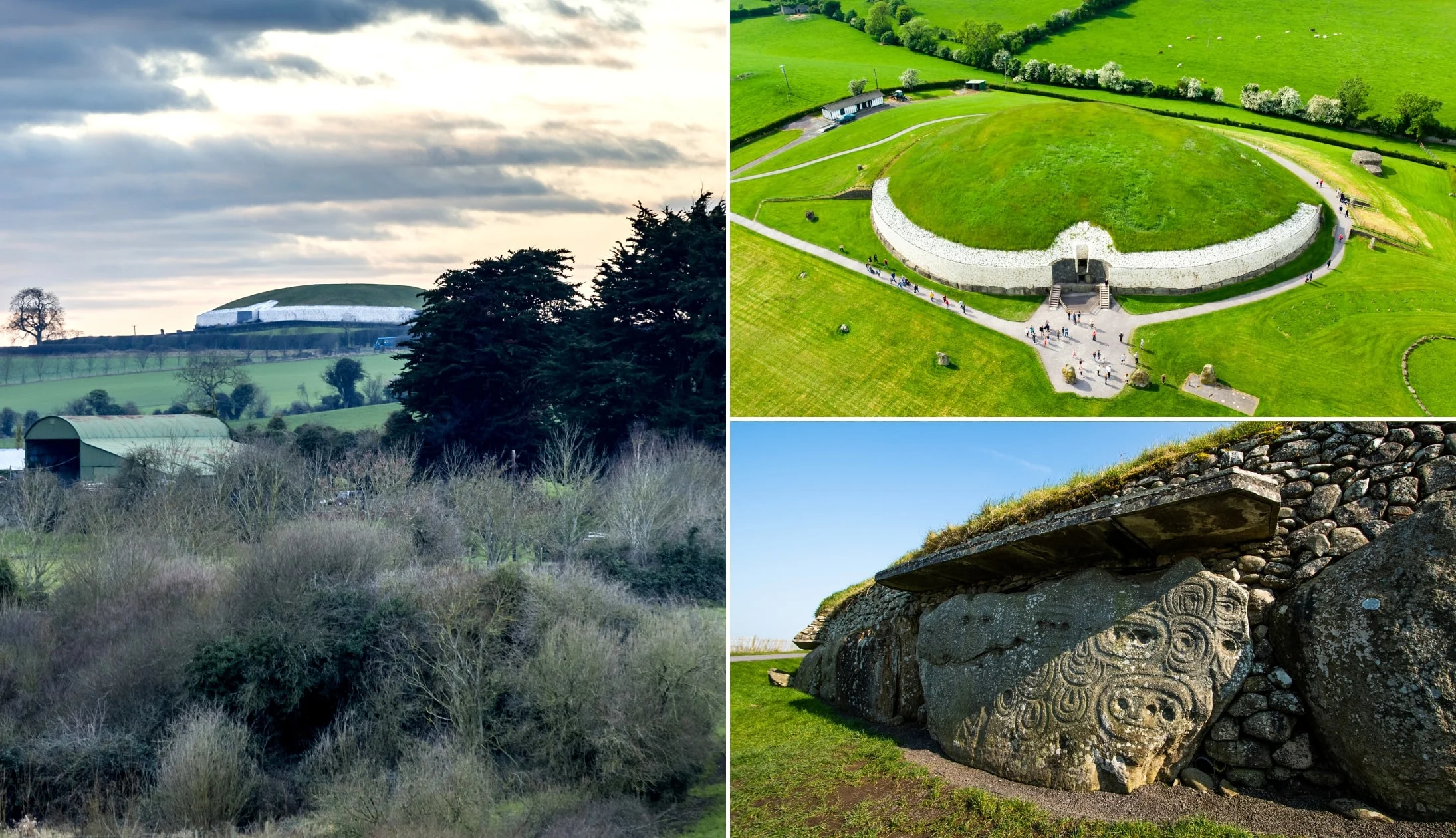
Photos via Shutterstock
Newgrange is a fascinating prehistoric monument and the main attraction in the Brú na Bóinne World Heritage Site. The neolithic passage tomb was built around 3200 BC, making it older than the Egyptian pyramids and Stonehenge!
From Dublin City Centre, it’s around a 45-minute drive (depending on traffic). We recommend setting out as early as possible to avoid traffic.
You can book your Newgrange Tour + Exhibition tickets here, pre-booking is essential. Please note, that you cannot go to the monuments directly, you must start at the Brú na Bóinne Visitor Centre. The Newgrange Tour is roughly one hour long.
Stop 2: St Peter’s Church Drogheda
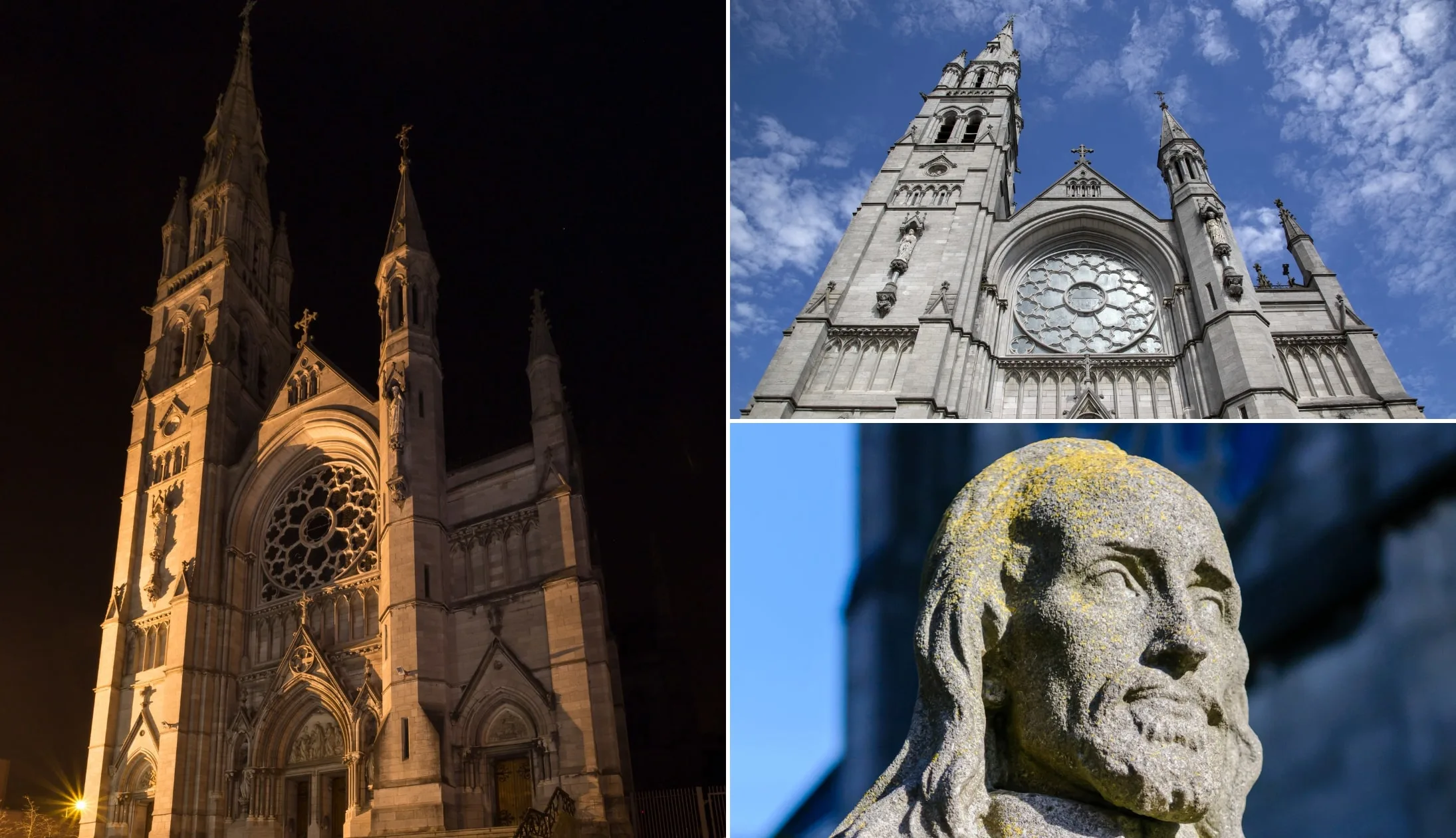
Photos via Shutterstock
Your next stop is St. Peter’s Church, a 15-minute drive from Newgrange. It’s a stunning French Gothic-style church that dates back to 1884.
It’s well known for being home to the national shrine to St. Oliver Plunkett, a Catholic archbishop who was executed in Tyburn, England for treason and “promoting the Roman Faith”.
The shrine is elaborate and detailed and contains the preserved head of St. Oliver Plunkett! Other artefacts on show include his bones and the cell door of his Newgate prison.
Please take care to observe complete silence in the church as it’s a sacred place.
Stop 3: Monasterboice

Photos via Shutterstock
Monasterboice is a 12-minute drive from the church. The ruins date back to the late 5th century and were founded by Saint Buithe.
The Christian settlement was an important centre of religion and learning in the area up until 1142 when the Mellifont Abbey was founded.
Highlights of the settlement are the 28-metre round tower, two church ruins, and the magnificent 10th-century high crosses – the Muiredach’s Cross and the West Cross (the tallest in Ireland).
We recommend spending around 30 minutes here.
Stop 4: Hill of Slane
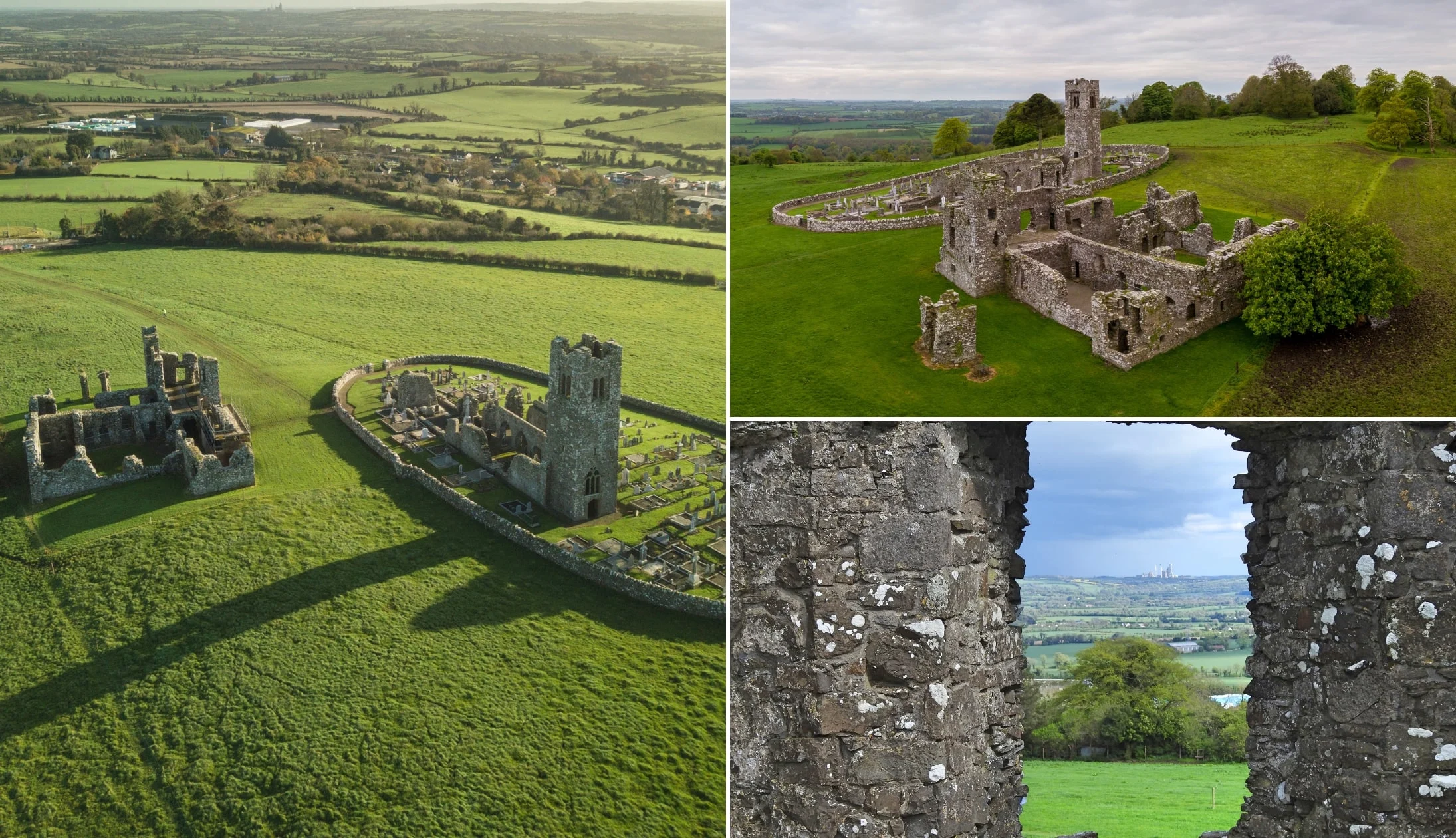
Photos via Shutterstock
The Hill of Slane is an incredibly important site, and a possible location for where St. Patrick lit the Paschal Candle, which represented Christianity coming to Ireland.
The site is home to 16th-century Franciscan Monastery ruins, built on top of an older monastery founded by St. Erc, one of St. Patrick’s followers.
It’s a 15-minute drive from Monasterboice, and we’d recommend spending between 30 minutes to an hour here depending on how much you want to explore.
Stop 5: Lunch in Navan
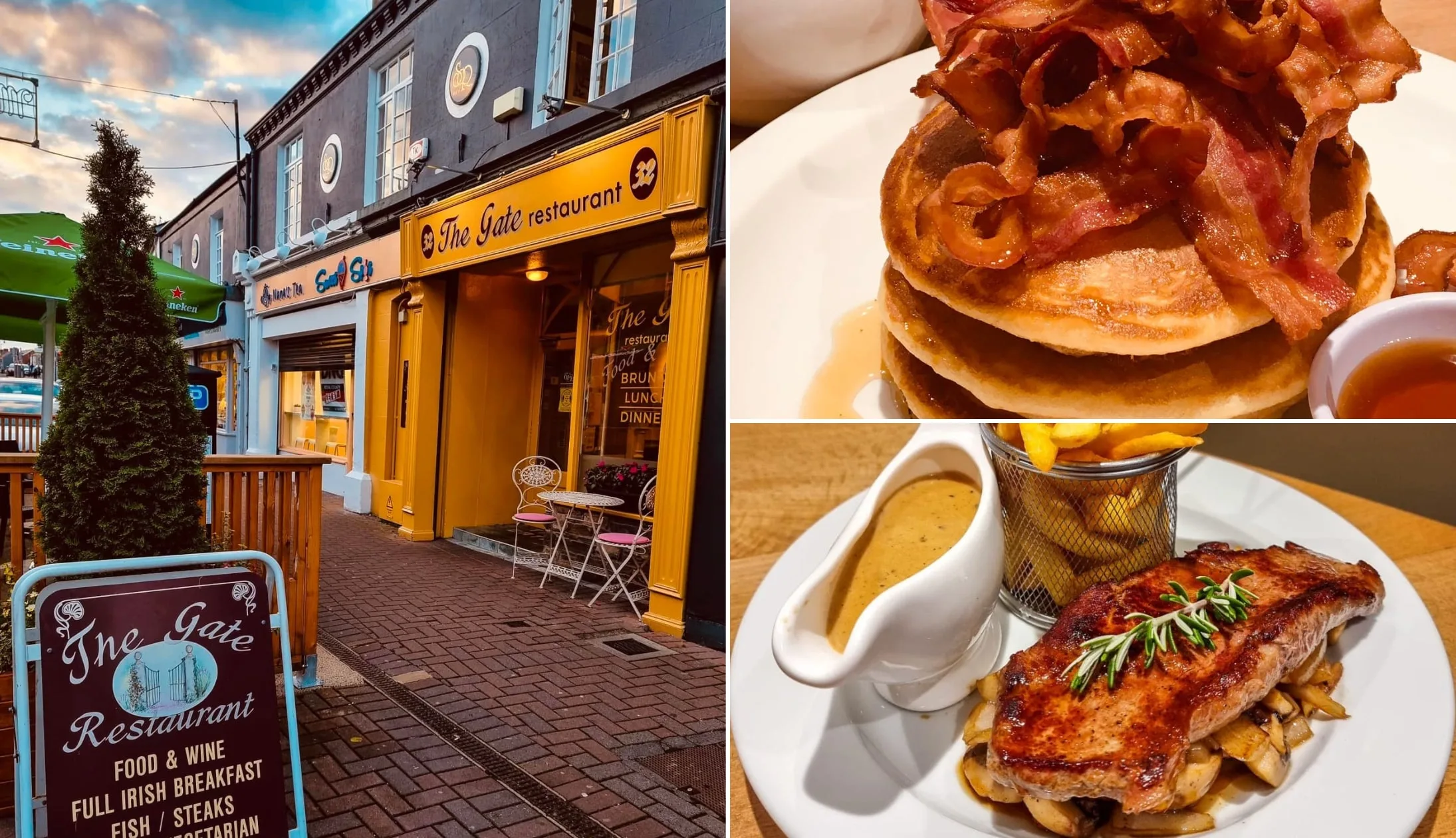
Photos via The Gate Restaurant on FB
Drive the 25 minutes to Navan to grab a bite of lunch. We recommend checking out The Gate Restaurant (a family-run restaurant serving Irish food) or the Crystal Cafe (a great spot for light bites like gourmet sandwiches and wraps).
Room8 (delicious salads and sandwiches – vegetarian and vegan friendly) and Checkov’s Cafe (a cosy spot for sandwiches and salads) are good options, too!
Stop 6: Kells Round Tower and High Crosses
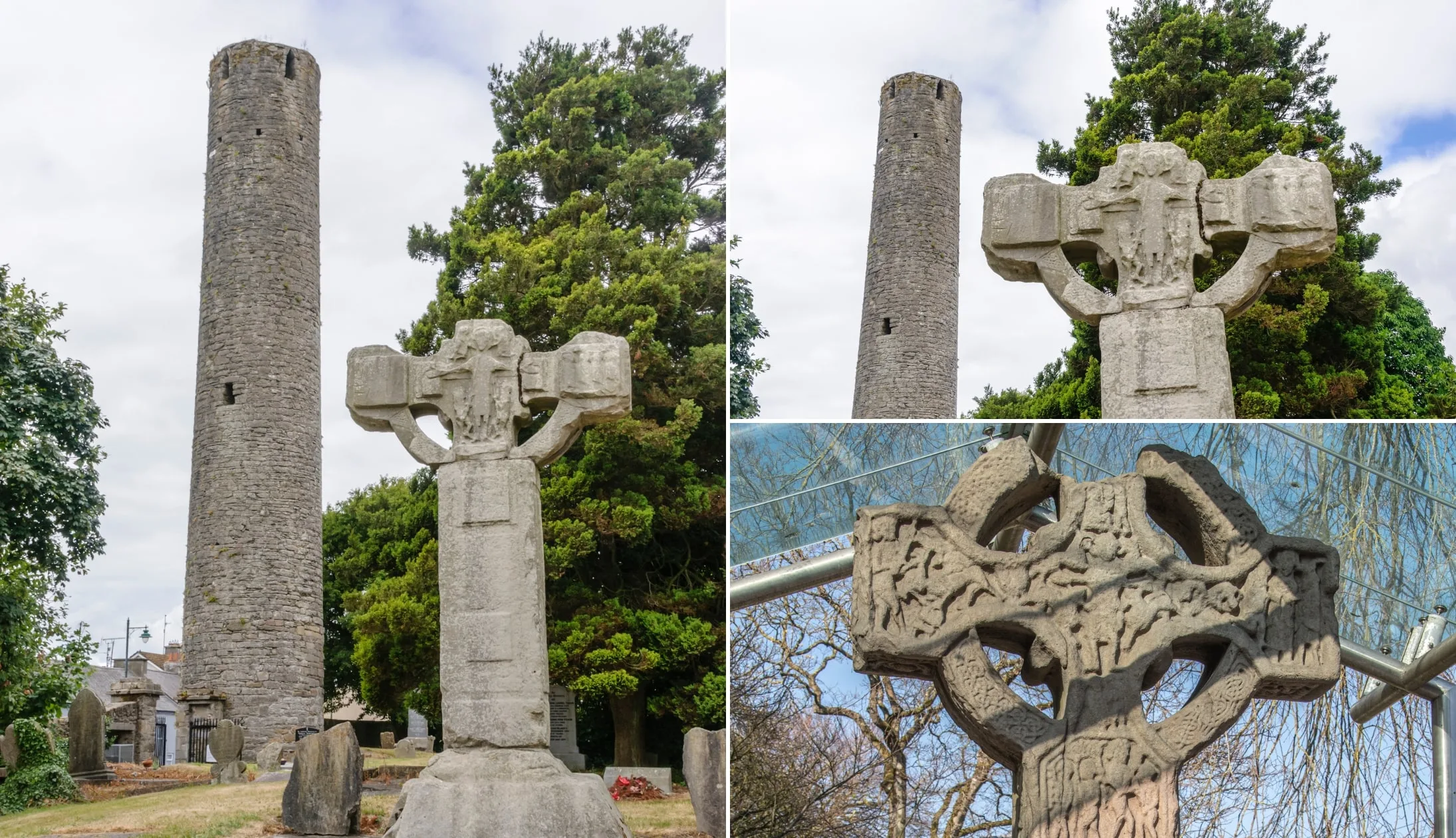
Photos via Shutterstock
Kells Round Tower and High Cross is a 17-minute drive from Navan. The tower and high cross are in the town of Kells, which was founded by Saint Columba in 550 AD.
The round tower is in good condition, but interestingly, unlike other round towers in the country, it has five upper windows instead of four.
Once you’ve had a look at the round tower (it’s 26 metres tall, you can’t miss it!), head over to admire the five high crosses: the South Cross, the West Cross, the East Cross, the Market Cross, and the North Cross (only the base remains).
The South Cross, also known as the Cross of St. Patrick and St. Columba, is the most impressive and in the best condition. It dates back to the 9th century, with intricate carvings of Adam and Eve and Cain and Abel, amongst other things.
Stop 7: Spire of Lloyd
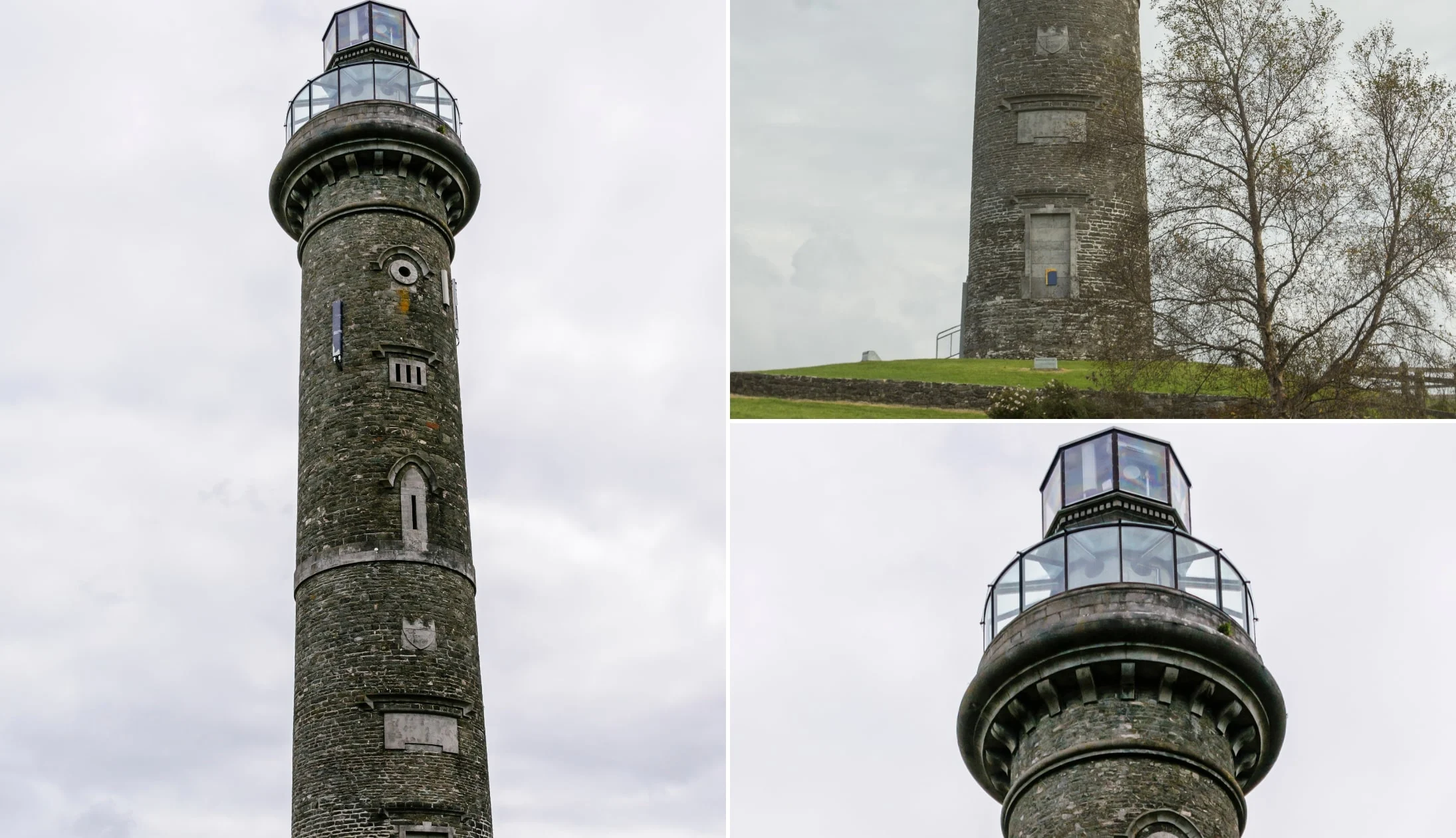
Photos via Shutterstock
The Spire of Lloyd is just a quick 4-minute drive away, and an interesting building sometimes referred to as “Ireland’s only inland lighthouse”!
It’s a long column with a 360-degree glass viewing room that is accessed via 164 stairs but please note that it’s rarely open to the public.
The 30-metre spire is said to have been used for watching horse races and hunting in the 19th century, although the racecourse in Kells was built after the tower.
The tower was built in 1791, although it was built on an Iron Age ring fort, with evidence that the site was used as far back as the Bronze Age!
Stop 8: Trim Castle
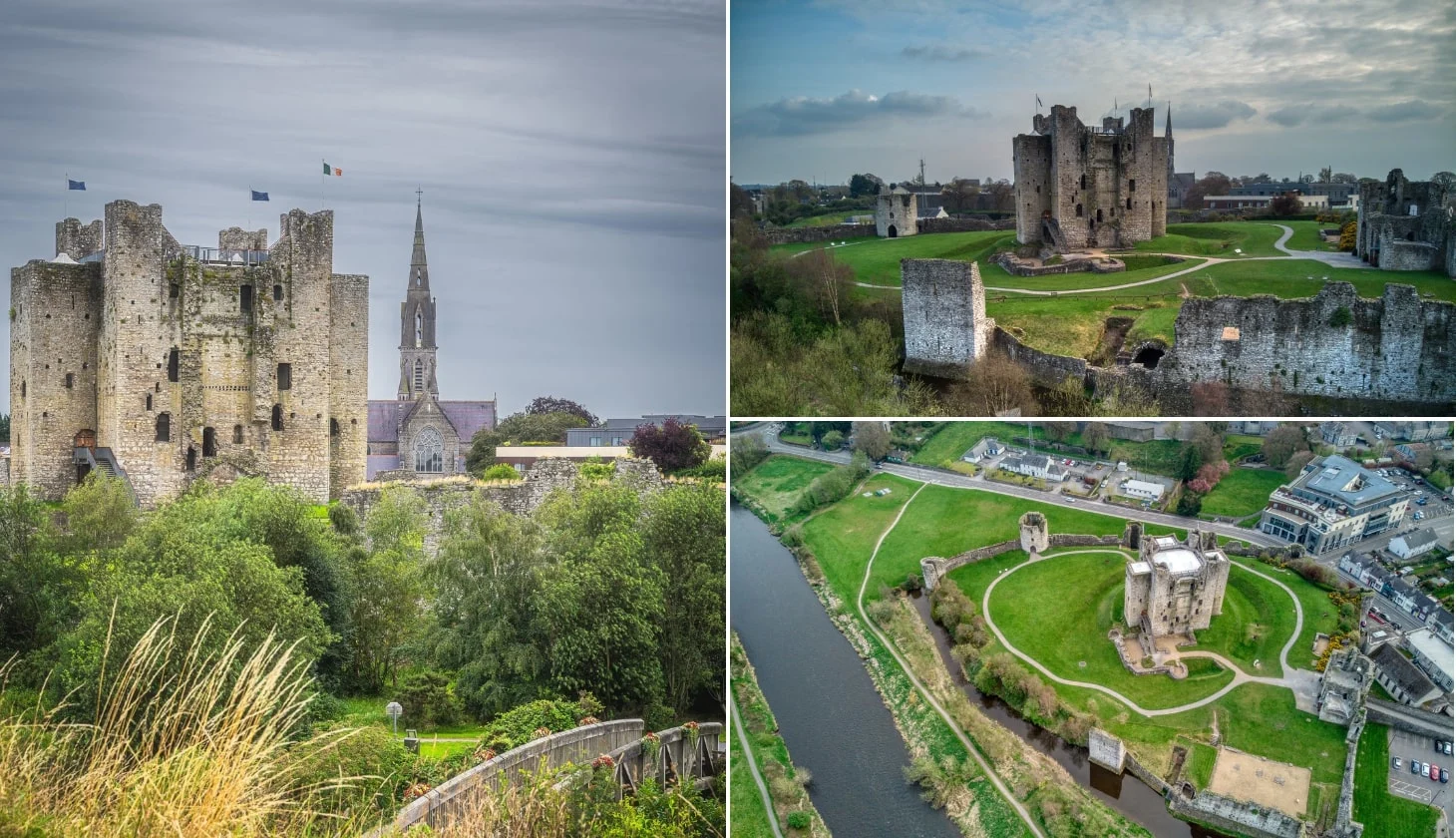
Photos via Shutterstock
Trim Castle is Ireland’s largest Anglo-Norman fortification. It’s very impressive with an imposing presence and it’s only 25 minutes away from Kells.
The Castle dates back to the 12th century and took Hugh de Lacy and his successors 30 years to complete.
It’s free to visit the castle grounds, but a guided tour of the keep costs €5 (adult), €4 (senior), €3 (student/child), and €13 (family).
The tour is well worth it, especially for any Braveheart fans, as parts of the movie were filmed there!
The castle is open daily between 10am and 5pm. We’d recommend at least 30 minutes to one hour here. It’s a 30-minute drive from the Spire of Lloyd.
Stop 9: Bective Abbey
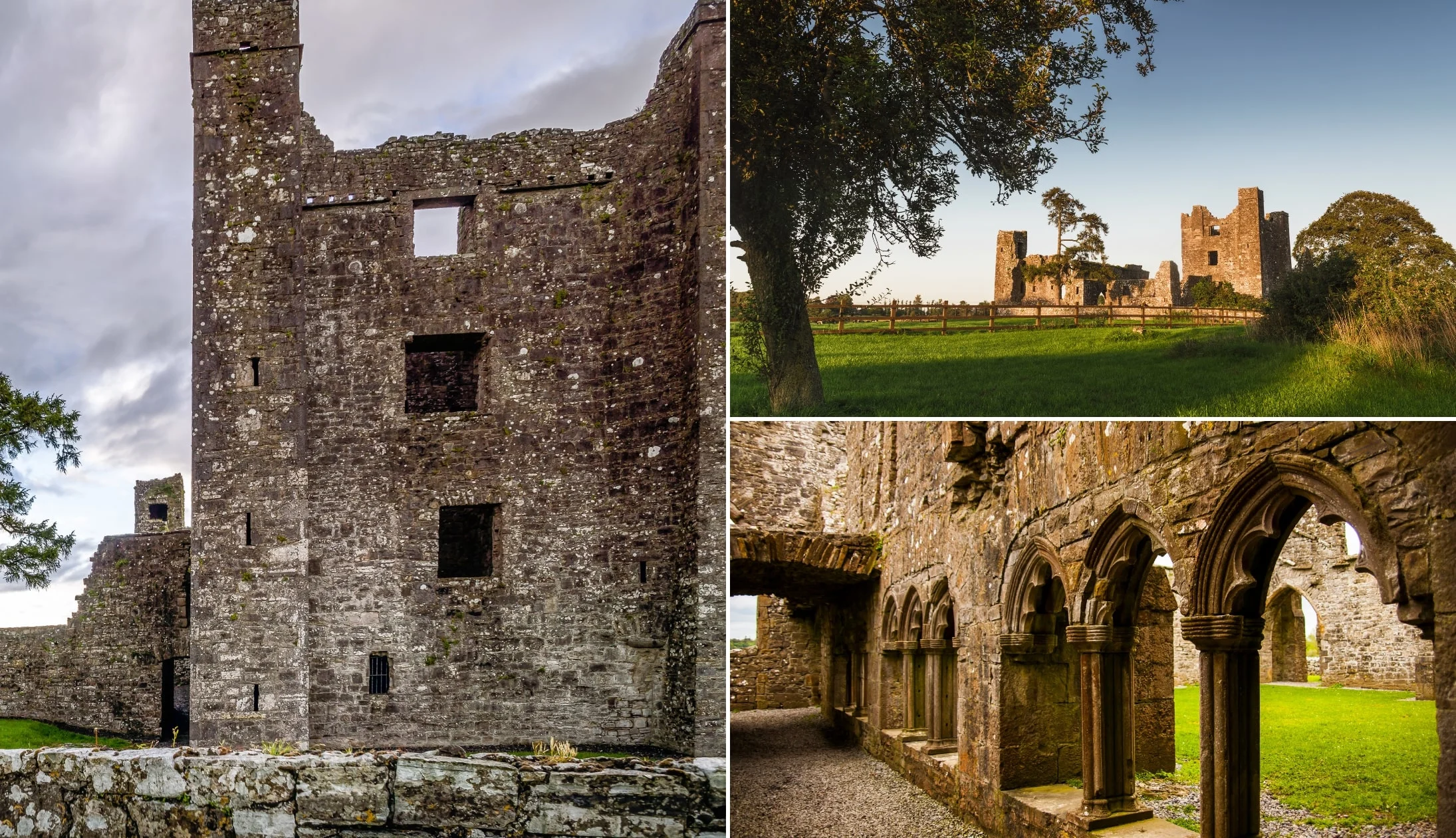
Photos via Shutterstock
The next stop is Bective Abbey, a 10-minute drive away. It was founded in 1147 for the Cistercian Order and became a significant monastic settlement.
The ruins you can see today mostly date back to the 13th and 15th centuries, with a chapter house, a church, and a cloister.
The ruins have been used several times in Hollywood movies. Most recently, in The Last Duel, which came out in 2020.
The abbey is free to visit with a designated car park. Give yourself around 30 minutes here.
Stop 10: Hill of Tara
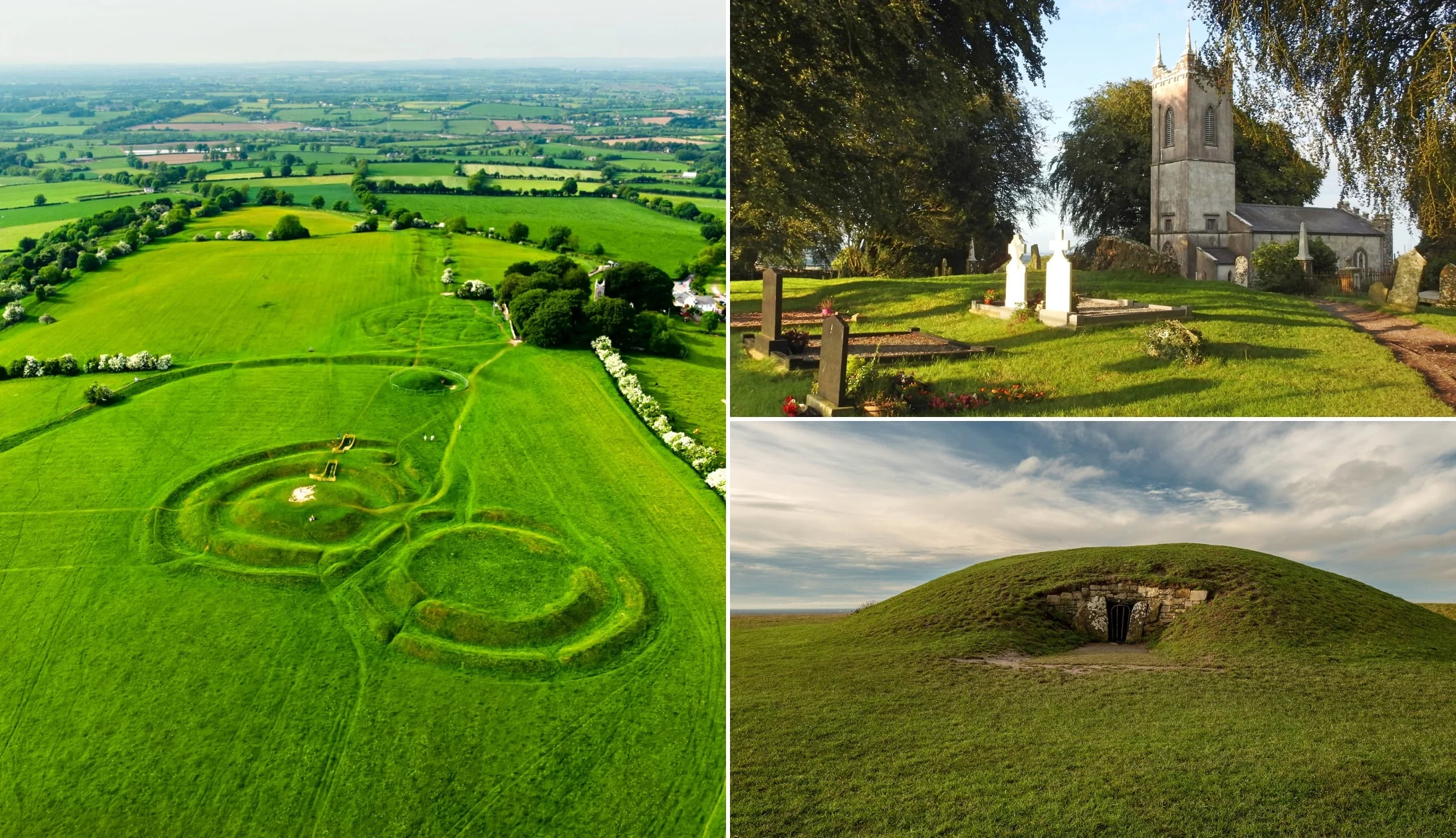
Photos via Shutterstock
The last stop of the day is the Hill of Tara. It’s a 12-minute drive from Bective Abbey and we’d say 30-45 minutes is a good amount of time to spend here.
The Hill of Tara has been in use since the late Stone Age, but it’s known best as the seat of the High Kings of Ireland, with all old Irish roads leading to the site!
The site is shrouded in myth, and the story of Conn of the Hundred Battles tells the tale of how the High Kings of Ireland came to be.
It’s free to visit, with a free 25-minute Audio Visual Show at the visitor centre (in the church), and free guided tours scheduled every day. The centre is open between 10am and 5pm year-round, but the site is open 24/7.
Stop 11: Back to Dublin for the night

Different trad bars in Dublin. © Tourism Ireland
From the Hill of Tara, it’s a 50-minute drive back to Dublin City Centre (depending on traffic).
Our dinner recommendations
If you’re looking for something close by, Spitalfields is a short walk from the cathedral. It’s a little bit pricey, but the atmosphere is great and the food is top-notch!
However, Spitalfields is 16+ only, so it’s not suitable for young families. Otherwise, check out The Bull and Castle across the street from Christ Church Cathedral.
Their menu has F.X. Buckley Steaks (renowned in Dublin), plus a great selection of local craft beers. The restaurant can get booked out pretty quickly, but you can always eat in the bar upstairs, which also has steak on the menu.
Live music and trad bars
If you want a taste of what Dublin’s best pubs are, see our detailed Dublin pubs guide. If you’re solely looking for places that do exceptional Guinness, see our guide to Dublin’s best pints.
If you fancy a bit of live music, there’s plenty on offer. Pipers Corner on Marlborough St. has some great tunes, with live music from 9pm every Tuesday to Saturday, and from 8pm on Sunday.
The inside has more of a modern feel, but you’ll be guaranteed authentic Irish music.
For the full experience, O’Donoghues Bar on Merrion Row has live music every night of the week. It’s about as traditional as Irish pubs get, with a brilliant atmosphere.
The Celt is another fantastic pub with live music every night from 9pm, although it’s not always traditional.
Day 4: Back To Dublin Airport

Photos via Shutterstock
It’s the last day, and time to head back to Dublin Airport and head home.
Depending on where you are in the city, you may need to drive through the port tunnel to get to the airport, so make sure you have cash or a card that taps.
Have plenty of time before your flight? Check out anything in the city that you weren’t able to see on your first day.
And that’s a wrap on this road trip
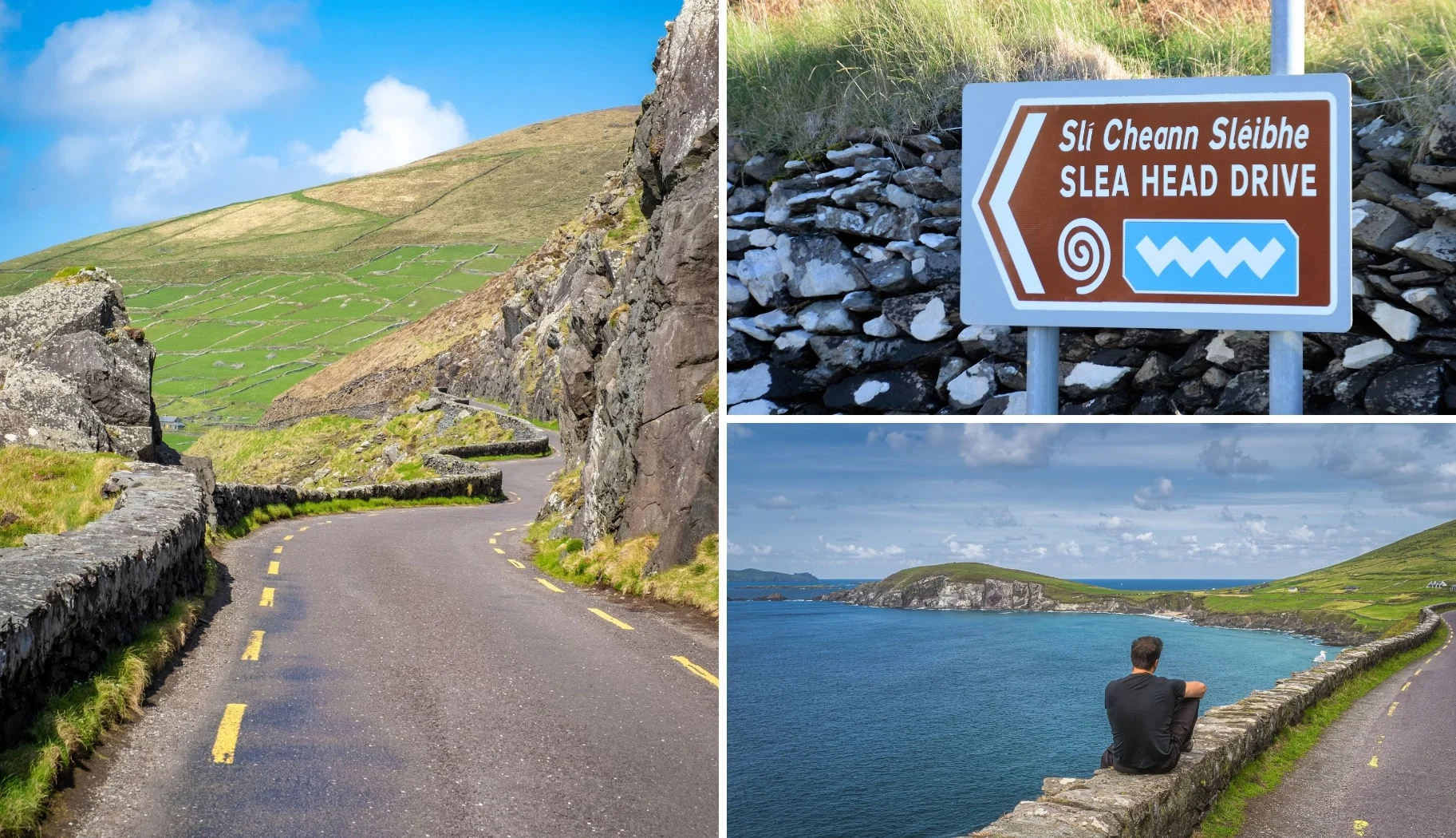
Photos via Shutterstock
We hope you found the above road trip guide useful. If you have any questions, ask in the comments below and we’ll do our best to help.
Or, if you’d like to browse our other Irish Road Trip itineraries, visit our Road Trip Hub – cheers!
Keith O’Hara has lived in Ireland for 35 years and has spent most of the last 10 creating what is now The Irish Road Trip guide. Over the years, the website has published thousands of meticulously researched Ireland travel guides, welcoming 30 million+ visitors along the way. In 2022, the Irish Road Trip team published the world’s largest collection of Irish Road Trip itineraries. Keith lives in Dublin with his dog Toby and finds writing in the 3rd person minus craic altogether.

